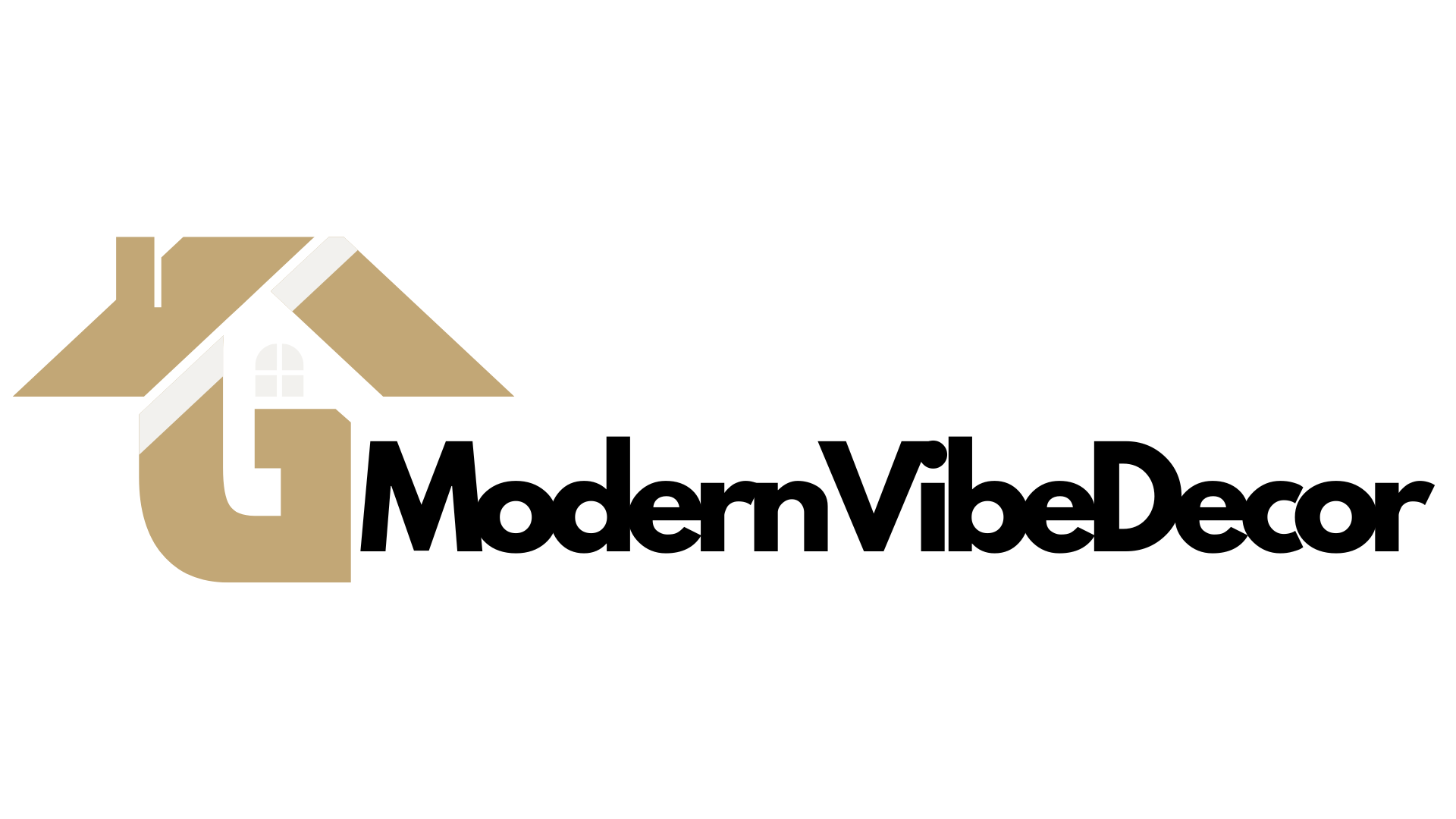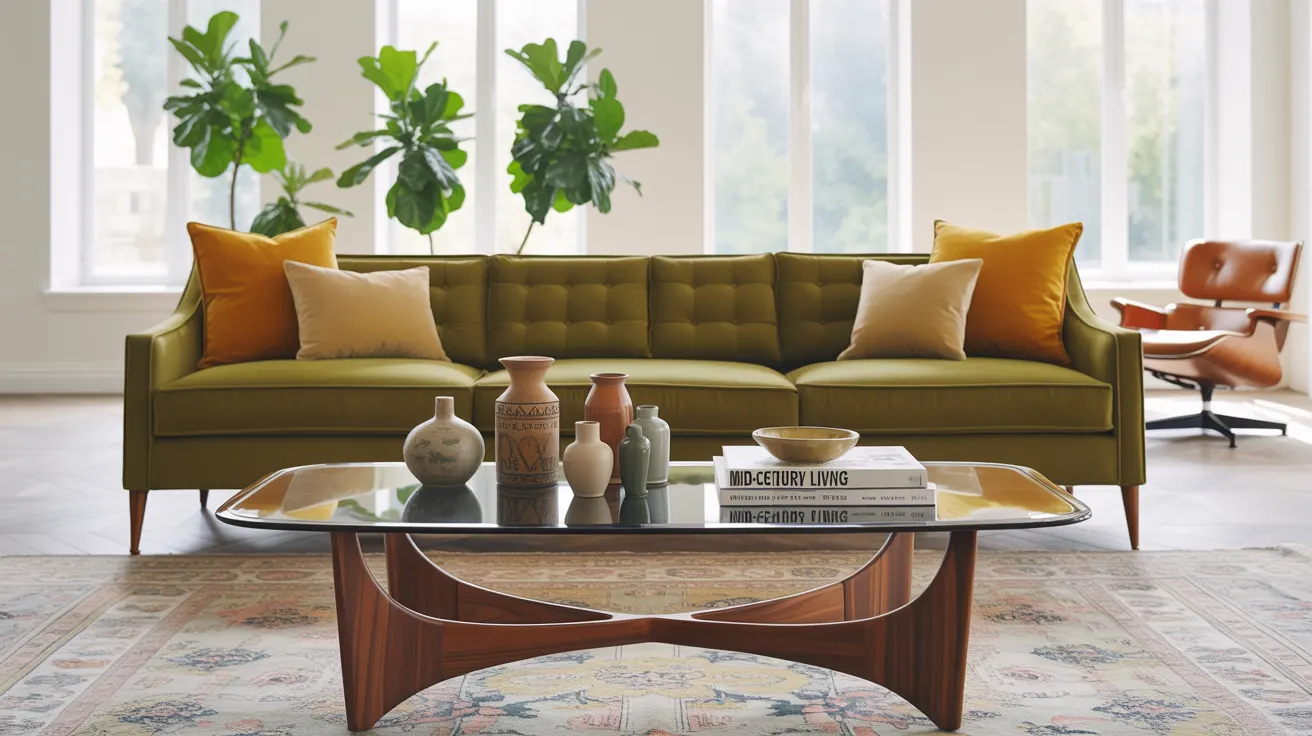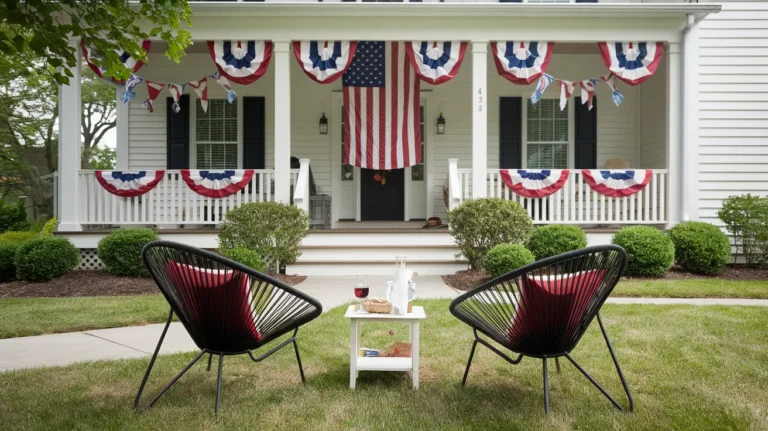Mid-century modern design is like that cool vintage record that never stops sounding fresh, no matter how many decades pass. There’s something about those clean lines, organic shapes, and perfect balance of form and function that continues to captivate us, even though the style originated way back in the 1940s and 50s.
I’ve been obsessed with mid-century modern design since I discovered my grandparents’ original Eames chair in their attic (and promptly begged to inherit it). What fascinates me most is how these decades-old designs still feel relevant and livable today—not like museum pieces, but like furniture meant for actual, everyday life.
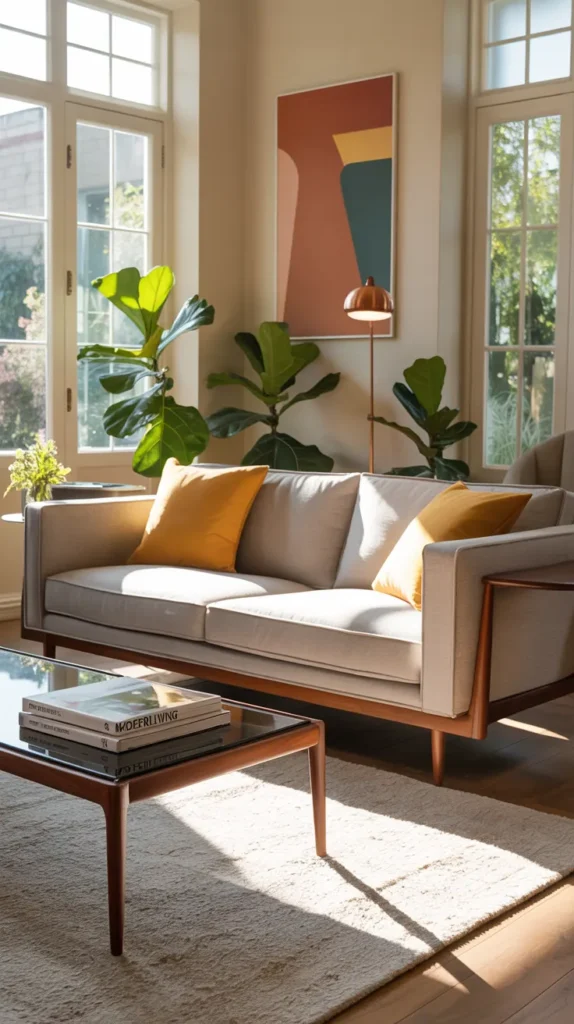
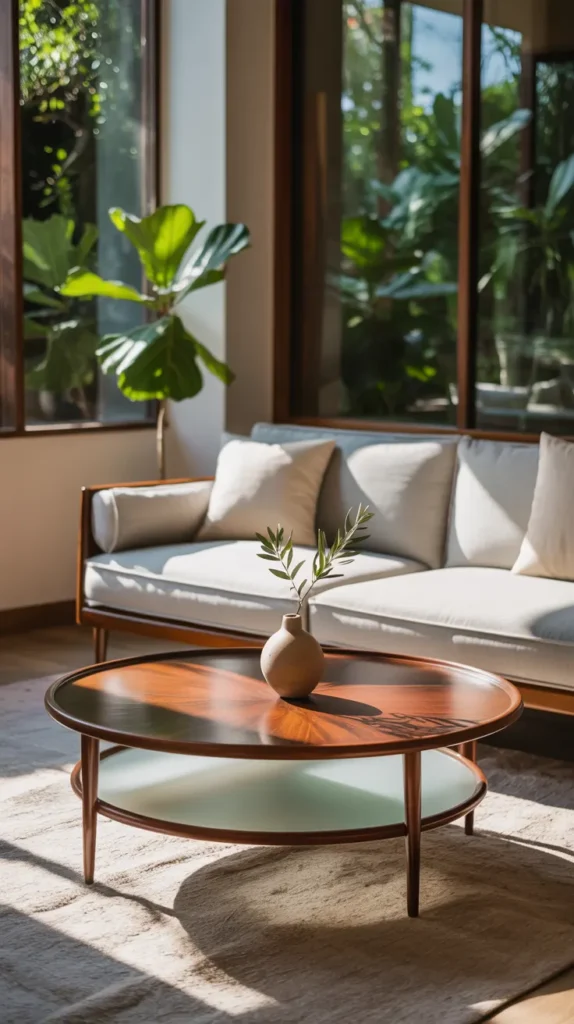
If you’re drawn to this timeless style but aren’t sure how to make it work in your home without creating a “Mad Men” set, you’re in the right place. Let’s explore over 20 amazing mid-century modern living room ideas that honor the era’s iconic style while feeling perfectly at home in the 21st century.
What Makes Mid-Century Modern So Special?
Before we dive into specific ideas, let’s talk about what defines mid-century modern design and why it continues to be so beloved by homeowners, designers, and architects alike.
Mid-century modern style emerged in America during the post-WWII period, when a new sense of optimism, prosperity, and interest in forward-thinking design was taking hold. Influenced by the Bauhaus movement and international style, American designers created furniture and spaces that were:
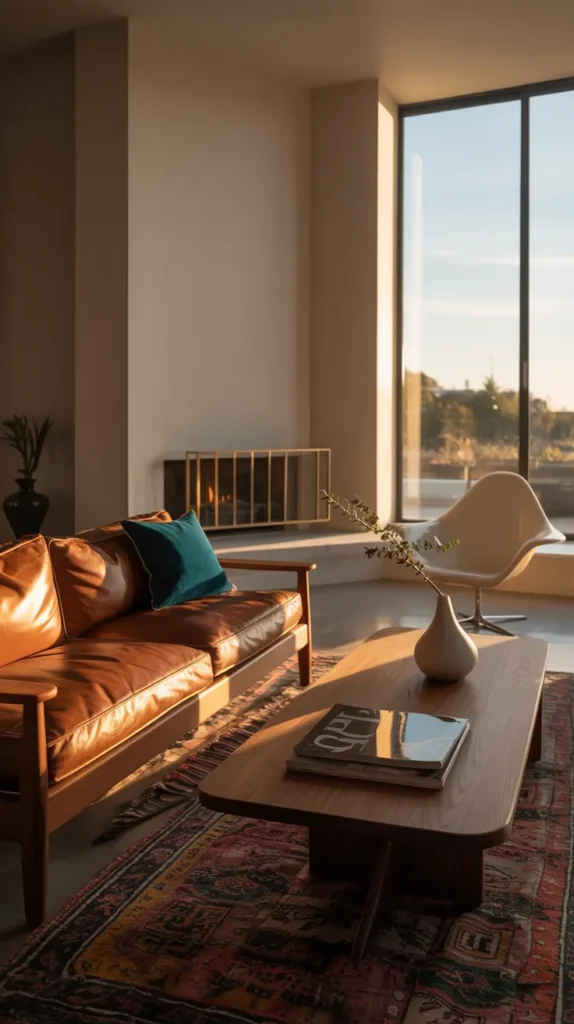
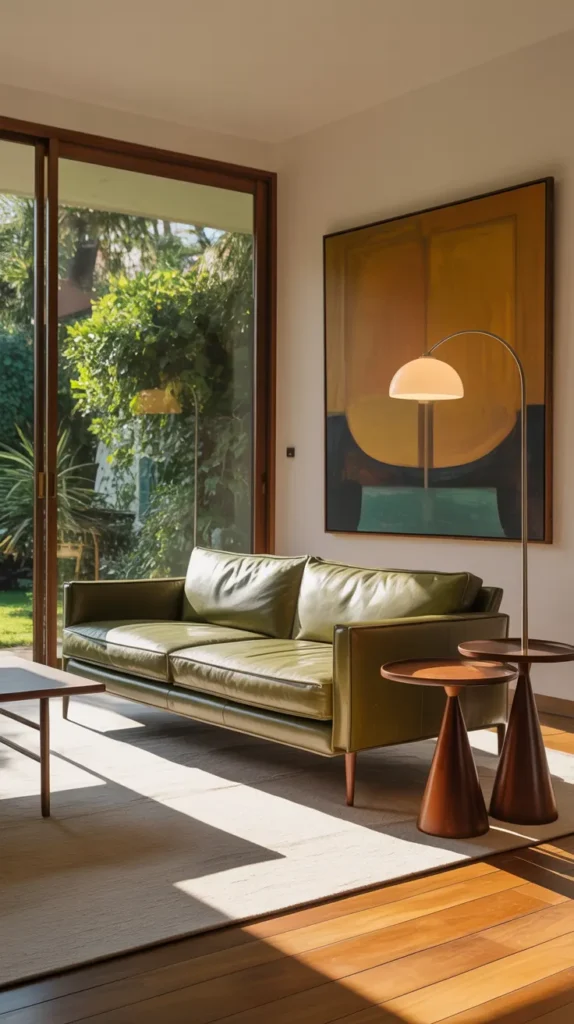
- Highly functional – Every piece serves a purpose; nothing exists purely for decoration
- Clean and uncluttered – Minimalist but not stark, with an emphasis on open space
- Connected to nature – Large windows, indoor-outdoor flow, and natural materials
- Accessible to many – Mass production made good design available to the middle class
- Forward-looking – Embracing new materials and production methods
This revolutionary approach to design still resonates today, especially as many of us seek to simplify our homes and lives, connect more with nature, and invest in quality pieces that will last.
Pro tip: Understanding the design philosophy behind mid-century modern helps you capture its essence rather than just copying a look. It’s about thoughtful, functional minimalism with warmth and connection to the natural world.
The Building Blocks: Essential Features of Mid-Century Living Rooms
Mid-century modern living rooms share several defining characteristics that give them their distinctive look and feel. Whether you’re going for a subtle nod to the era or a more comprehensive mid-century makeover, incorporating these elements will help you achieve that coveted retro-yet-timeless vibe.
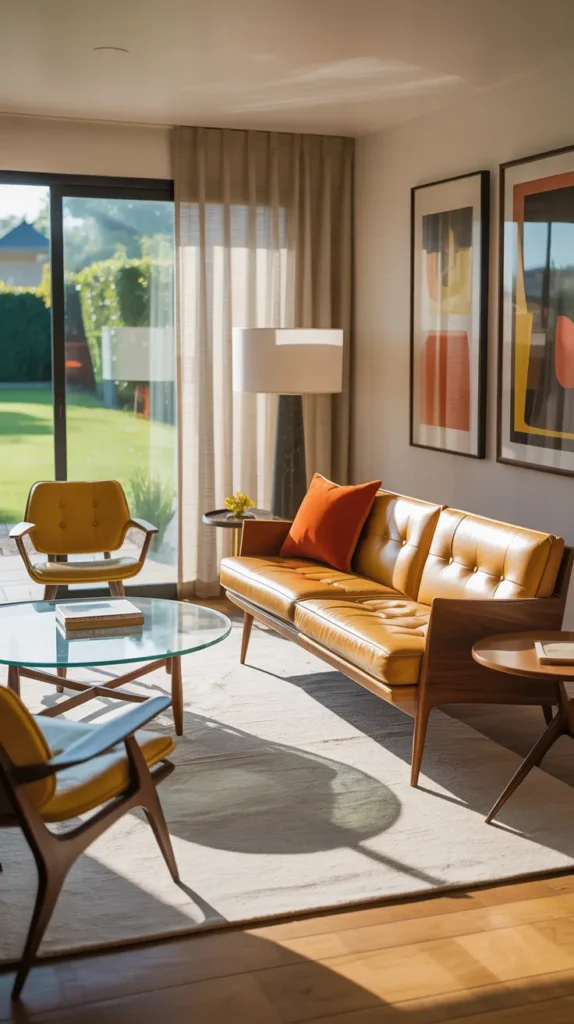
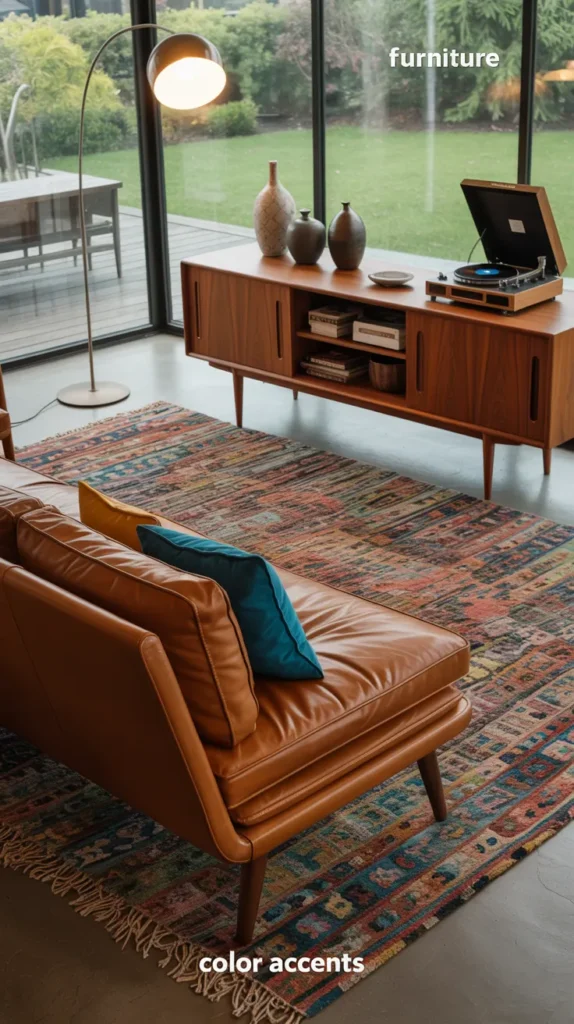
Clean Lines and Organic Forms
Mid-century furniture strikes a beautiful balance between geometric precision and organic curves. Think sofas with straight, boxy frames but softly curved cushions. Coffee tables with oval tops on slender, angled legs. Armchairs that cradle the body in sculptural shells.
This play between straight lines and gentle curves creates visual interest without busyness—one of the secrets to mid-century modern’s enduring appeal. The silhouettes are simple enough to blend with many styles but distinctive enough to make a statement.
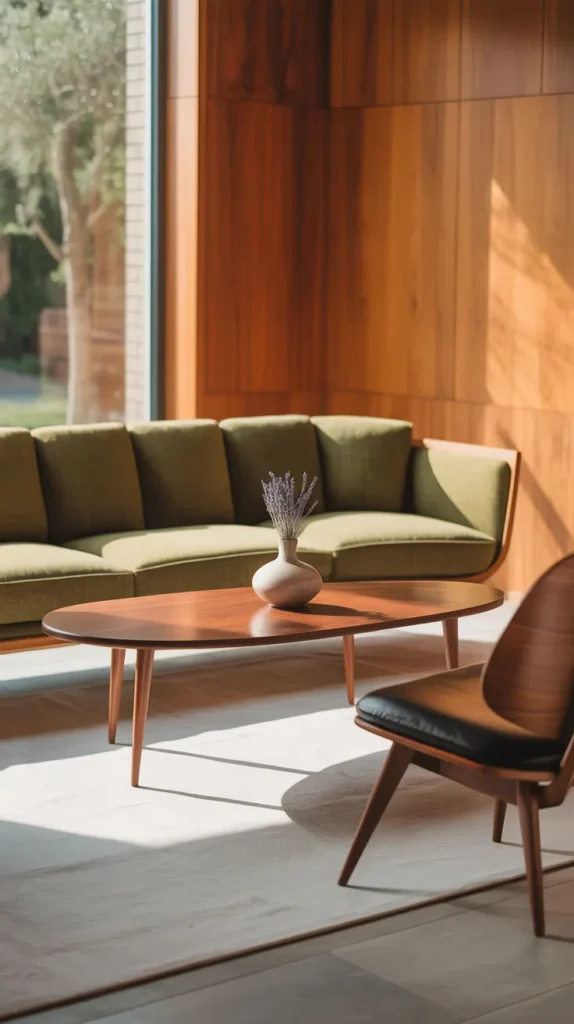
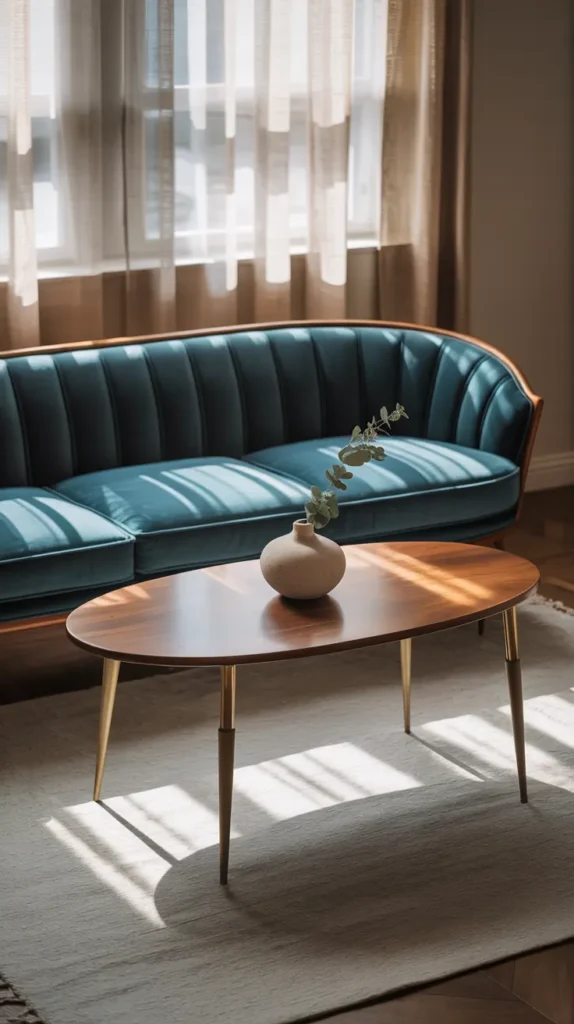
I recently helped a friend choose a new sofa, and we opted for a classic mid-century silhouette with a tufted bench seat and bolster pillows. The clean lines immediately elevated her living room, making her existing pieces look more intentional just by association.
Natural Materials Meet Innovation
Mid-century designers loved natural materials, particularly wood, but they weren’t afraid to pair them with innovative materials of their era like fiberglass, plexiglass, and metal. This juxtaposition creates a beautiful tension that keeps mid-century rooms from feeling too cold or too rustic.
In a mid-century living room, you might find:
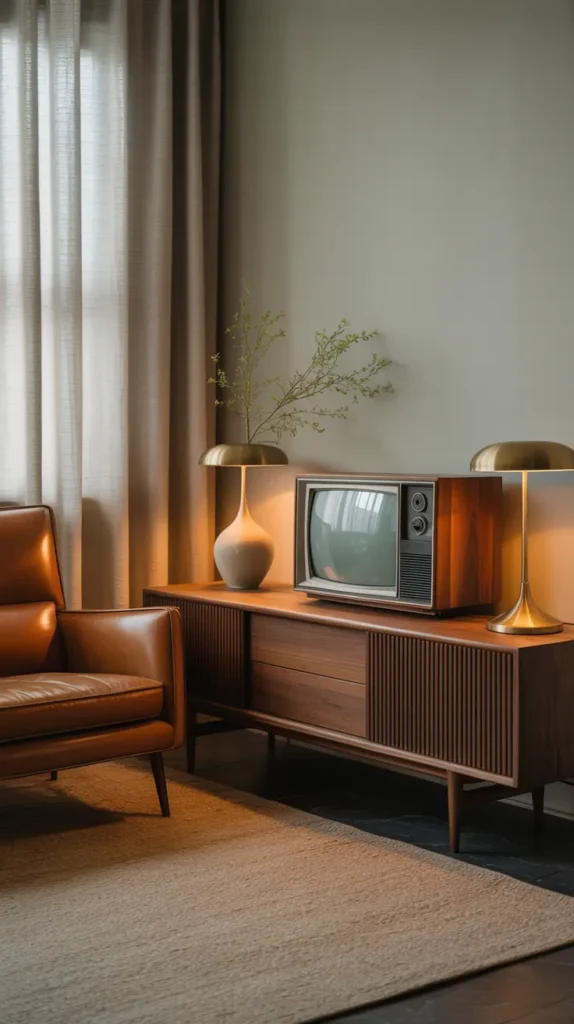
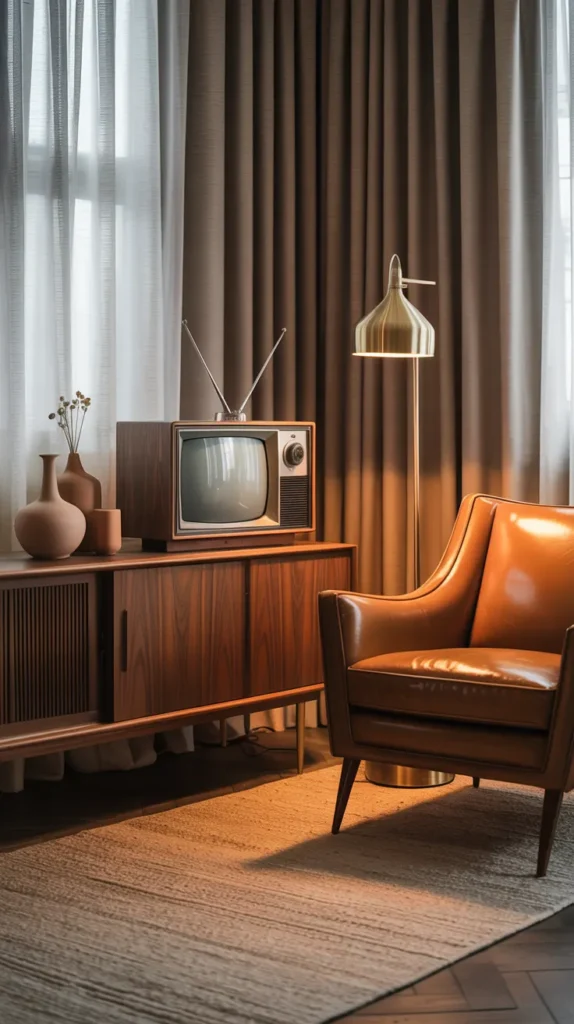
- Walnut, teak, or rosewood furniture with beautiful grain patterns
- Leather upholstery in caramel, chocolate, or black
- Brushed or polished metals like brass, stainless steel, or aluminum
- Glass surfaces for coffee tables or shelving
- Natural stone like marble for accent pieces
What makes these material combinations distinctly mid-century is how they’re used—wood isn’t distressed or reclaimed but rather celebrated for its natural beauty and often stained to enhance the grain. Metals are typically slender and used for legs, frames, or accents rather than as primary surfaces.
Open, Airy Spaces Filled with Light
Original mid-century homes featured open floor plans and large windows long before these became standard features in contemporary architecture. This emphasis on openness, natural light, and connection to the outdoors remains central to mid-century modern living rooms today.
Even if your home wasn’t built in the mid-century era, you can capture this quality by:
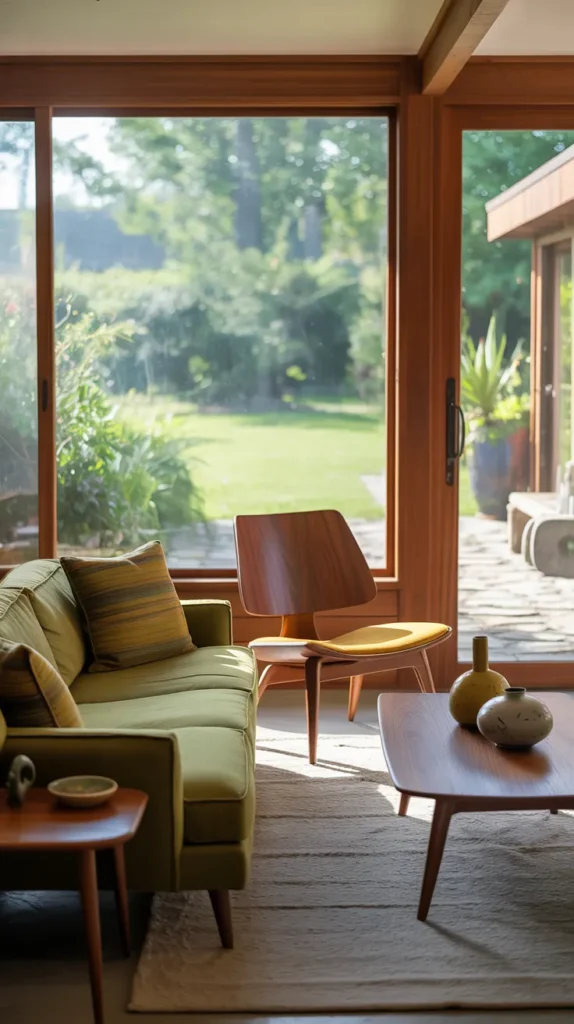
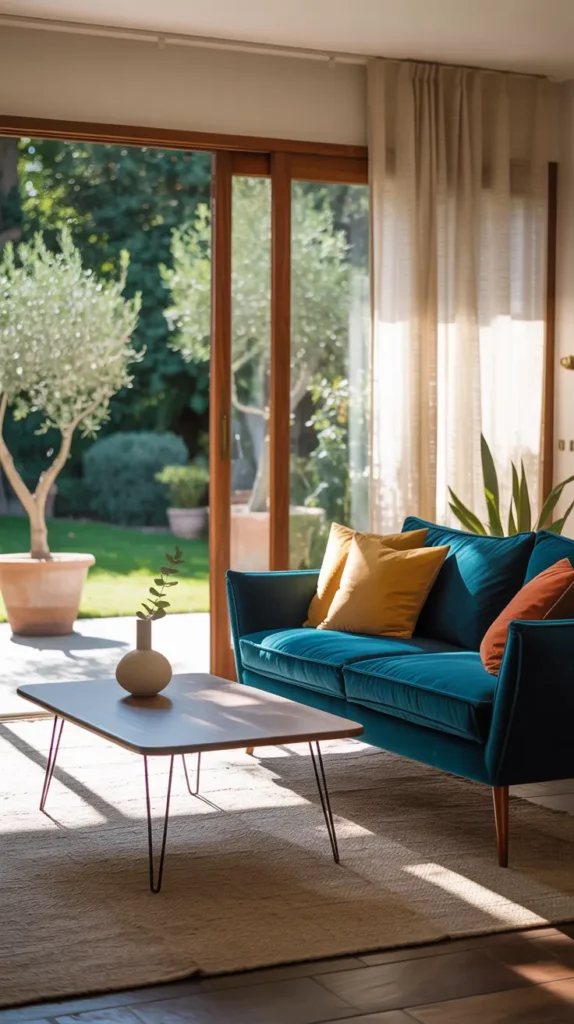
- Minimizing window treatments or choosing simple, streamlined options
- Arranging furniture to promote flow and conversation rather than facing a TV
- Using slender, elevated furniture that creates a sense of space underneath
- Incorporating houseplants that reinforce the indoor-outdoor connection
- Keeping decoration minimal to let the architecture and key furniture shine
The goal is to create a space that feels expansive and connected rather than closed-off and cluttered—a pleasant contrast to earlier design eras that favored compartmentalized rooms and heavier furnishings.
Understated Color Palette with Strategic Pops
Contrary to some misconceptions, mid-century modern isn’t all about bright orange and avocado green (though those colors certainly had their moment!). True mid-century spaces often feature relatively neutral backgrounds punctuated by carefully chosen color moments.
A classic mid-century color approach includes:
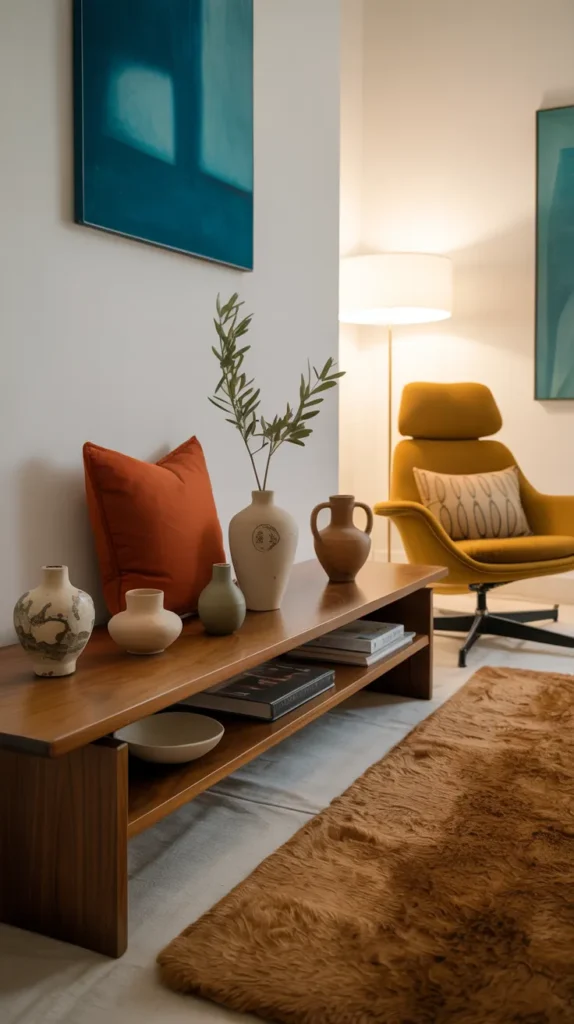

- Warm neutrals like beige, tan, and cream
- Natural wood tones ranging from honey to deep walnut
- Black and white for contrast and definition
- Strategic pops of color in burnt orange, olive green, mustard yellow, or teal
The key word here is “strategic”—rather than splashing color everywhere, mid-century spaces use it thoughtfully for emphasis and energy, often through an accent chair, artwork, or accessories.
I transformed my own living room by painting the walls a warm white and letting my caramel leather sofa and walnut coffee table take center stage. The only bold color comes from a vintage abstract print and a pair of mustard yellow pillows—simple but effective.
20+ Amazing Mid-Century Modern Living Room Ideas
Now that we understand the foundations of mid-century style, let’s explore specific ideas to bring this timeless aesthetic into your living room, whether you’re going for subtle inspiration or a full-on mid-century revival.
1. The Statement Sofa
If you invest in just one mid-century piece, make it a sofa. A classic mid-century sofa—with its tufted bench seat, tapered legs, and clean-lined silhouette—instantly establishes the style and provides a foundation for the rest of your design.
Look for:
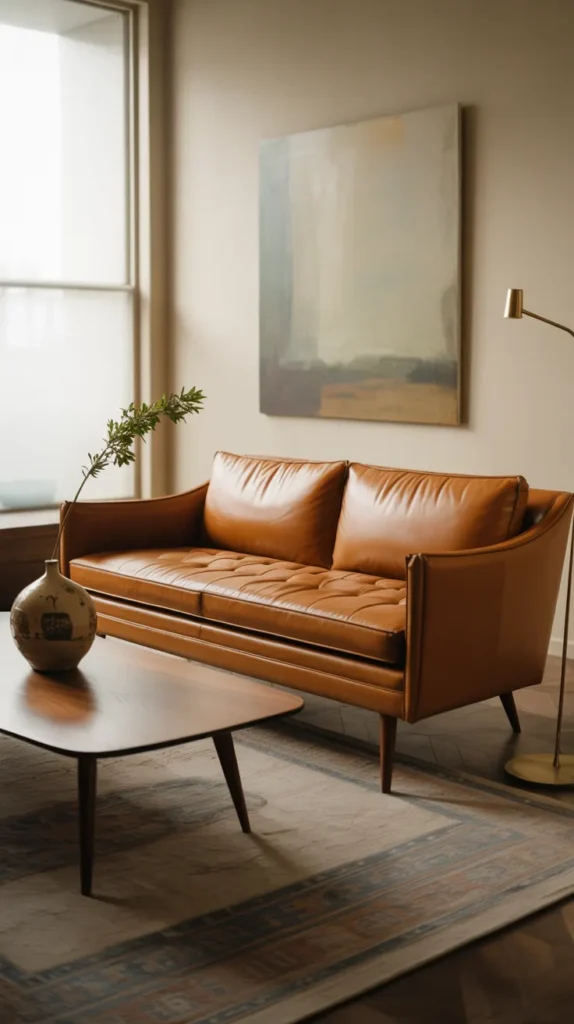
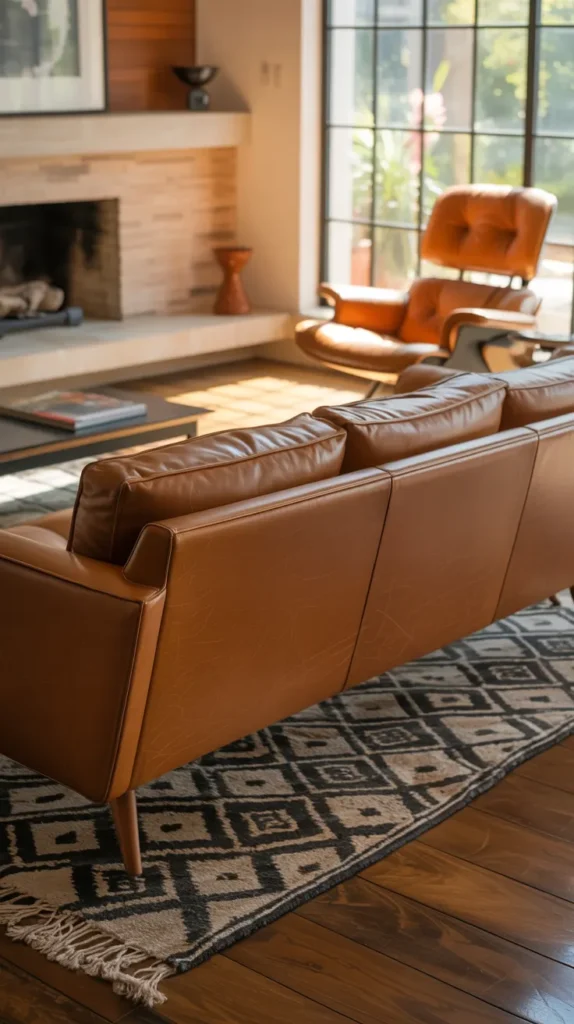
- Straight, boxy frames with minimal ornamentation
- Tufted cushions that sit within the frame rather than overflowing it
- Elevated legs that taper slightly and angle outward
- Upholstery in leather, wool, or tightly-woven fabrics
What I love about mid-century sofas is their versatility. They work beautifully with many other styles, from contemporary to eclectic, meaning you can evolve your décor over time without having to replace your main seating.
2. The Conversation Pit Reimagined
Original mid-century homes sometimes featured “conversation pits”—sunken seating areas designed to promote interaction. While you probably don’t want to dig a hole in your living room floor, you can capture this concept by arranging furniture to encourage face-to-face conversation.
Try:
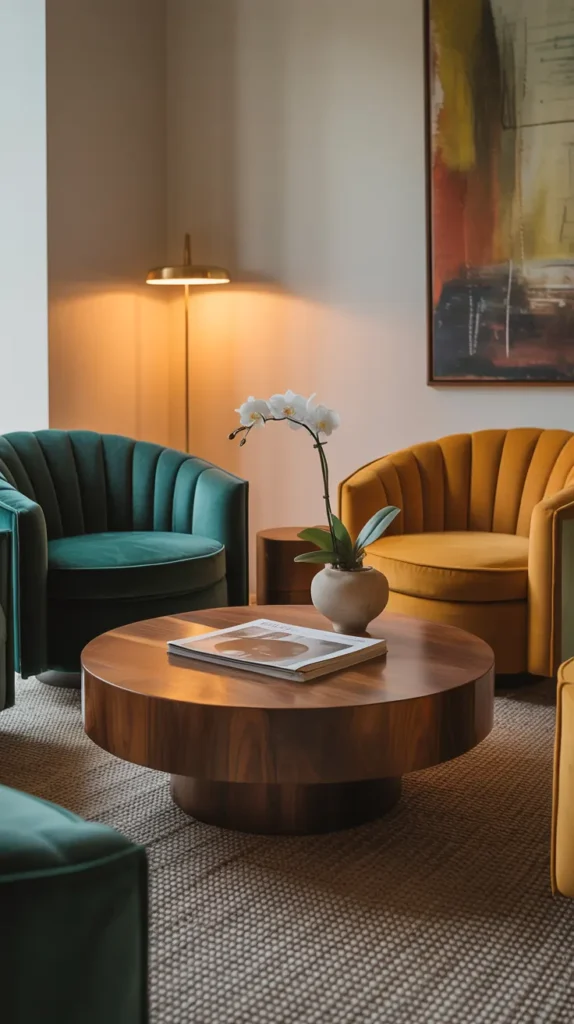
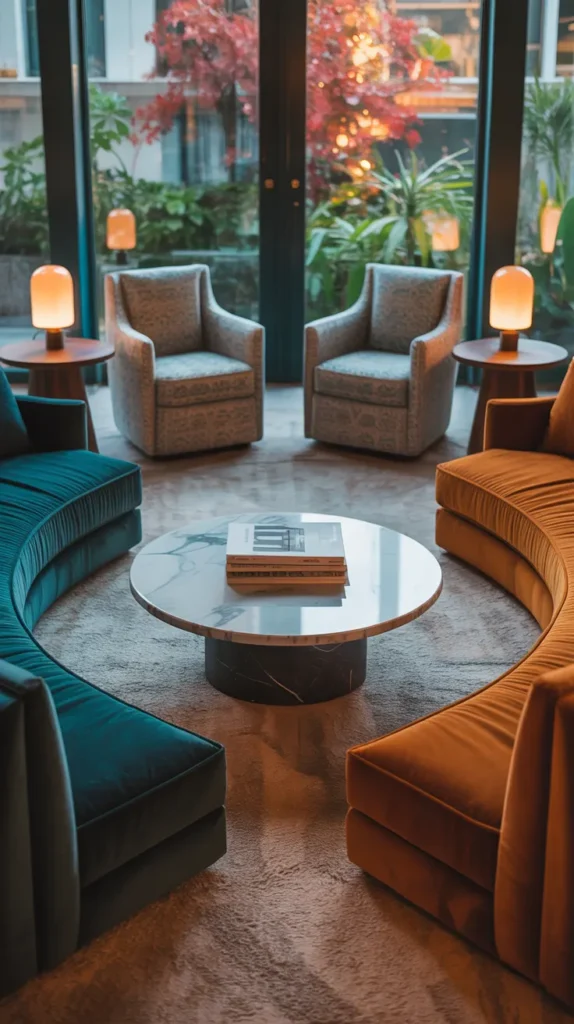
- Positioning seating in a U or circle rather than along walls
- Using a round coffee table as a central anchor
- Incorporating swivel chairs that can turn toward different conversation partners
- Keeping the TV peripheral rather than making it the room’s focus
This arrangement honors the mid-century emphasis on human connection and hospitality—values that feel increasingly relevant in our screen-dominated world.
3. Walnut Wonderland
No wood is more synonymous with mid-century design than walnut. Its rich, warm tone and distinctive grain patterns feature prominently in iconic pieces from the era and can bring instant mid-century character to your living room.
Incorporate walnut through:
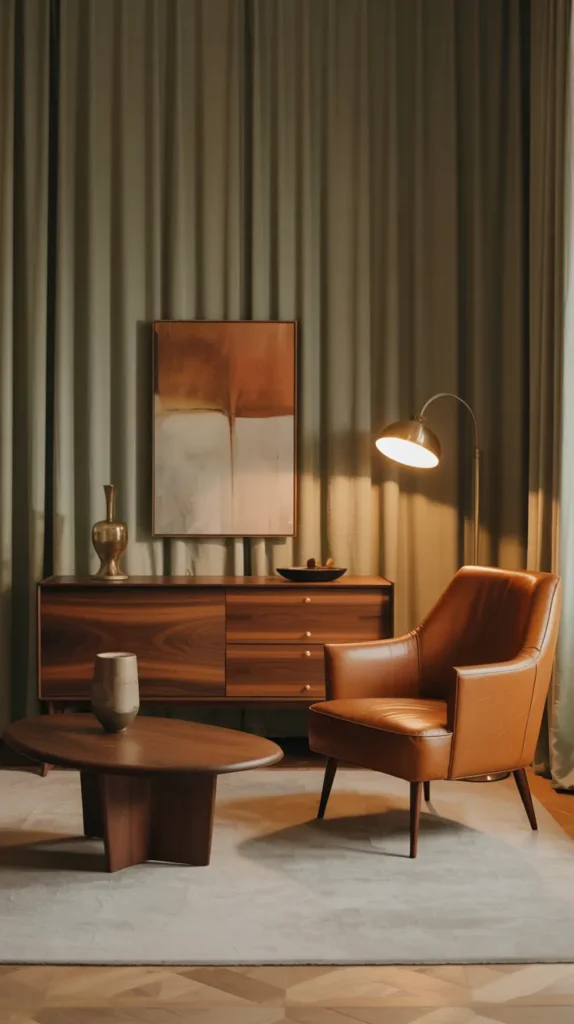
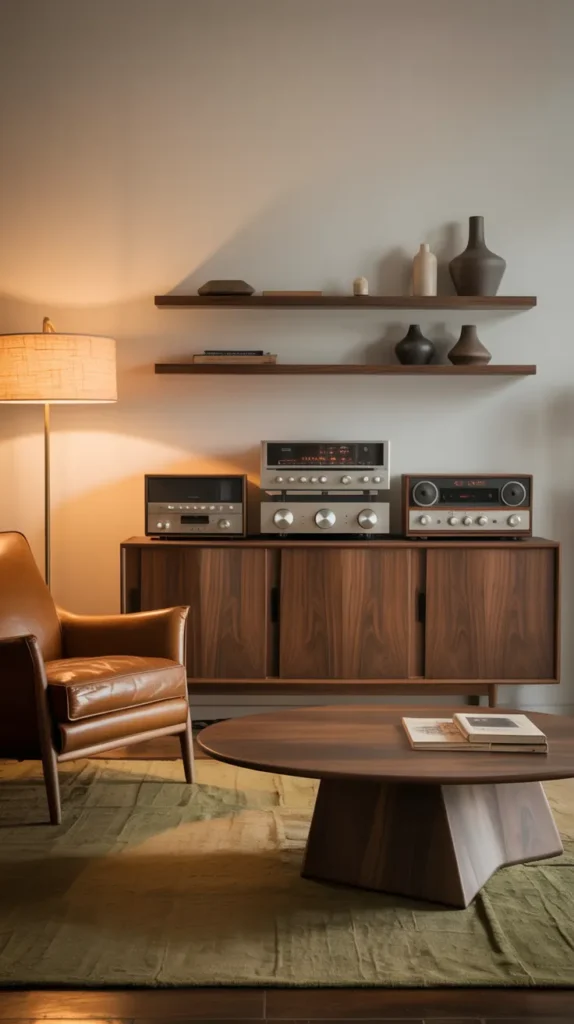
- A credenza or media console along one wall
- A coffee table with sculptural base
- Accent tables with slender, tapered legs
- Wall shelving or room dividers
- Picture frames for artwork or mirrors
If authentic walnut furniture exceeds your budget, look for quality veneer pieces, which were actually common during the original mid-century era. Many prestigious designers utilized veneer for its consistency and sustainability.
4. Iconic Chair Moment
Mid-century modern gave us some of the most recognizable chair designs in history. Adding just one iconic chair can establish mid-century credibility while creating a natural focal point in your living room.
Consider classics like:
![]()
![]()
- The Eames Lounge Chair and Ottoman
- The Egg Chair by Arne Jacobsen
- The Womb Chair by Eero Saarinen
- The Wishbone Chair by Hans Wegner
- The Butterfly Chair (originally the Hardoy Chair)
If original or authorized reproductions aren’t within reach, many furniture companies offer inspired designs that capture the essence of these icons without the premium price tag. Place your statement chair in a corner with good lighting to create a distinctive reading nook.
5. Sputnik Lighting
Named after the first satellite launched into orbit during the Space Age, sputnik chandeliers feature multiple arms extending from a central sphere—a perfect embodiment of the atomic age enthusiasm that influenced mid-century design.
A sputnik-style light fixture:
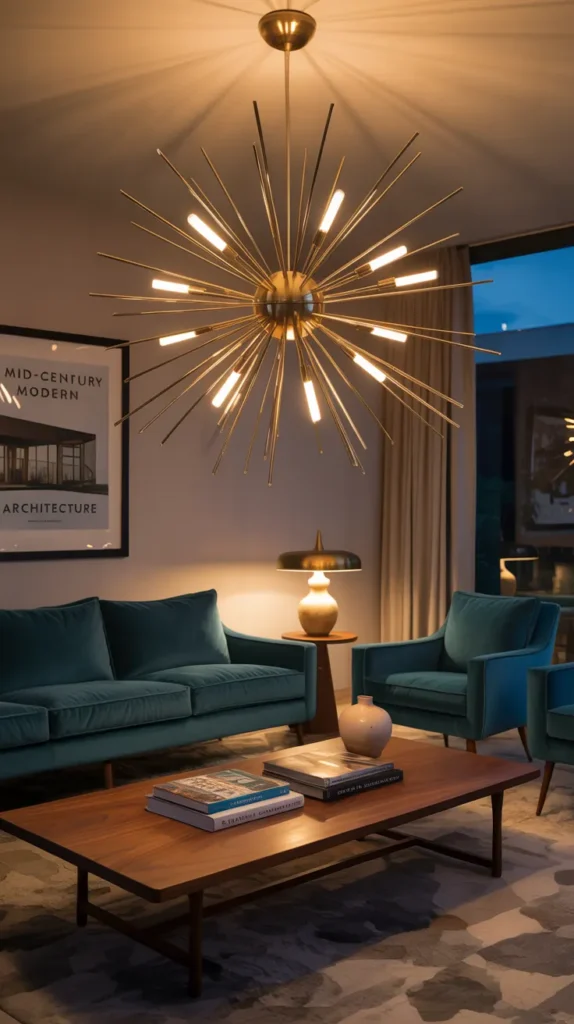
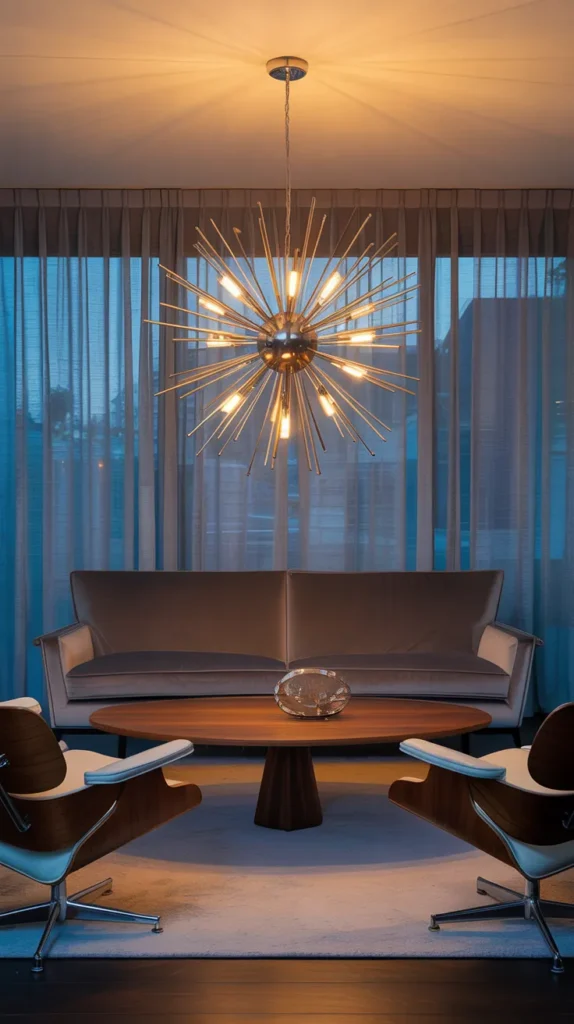
- Creates an immediate visual impact
- Reinforces the mid-century modern aesthetic
- Provides ambient lighting that radiates in multiple directions
- Adds a sculptural element to the ceiling plane
Modern versions come in various sizes and finishes, from brass to black to chrome, making it easy to find one that complements your particular color scheme. For maximum impact, center it over your main seating area or coffee table.
6. Sunburst Clock or Mirror
Another iconic mid-century decorative element is the sunburst design, most commonly seen in wall clocks and mirrors. These starburst shapes reflect the era’s fascination with space and celestial bodies while adding visual interest to walls.
A sunburst piece can:
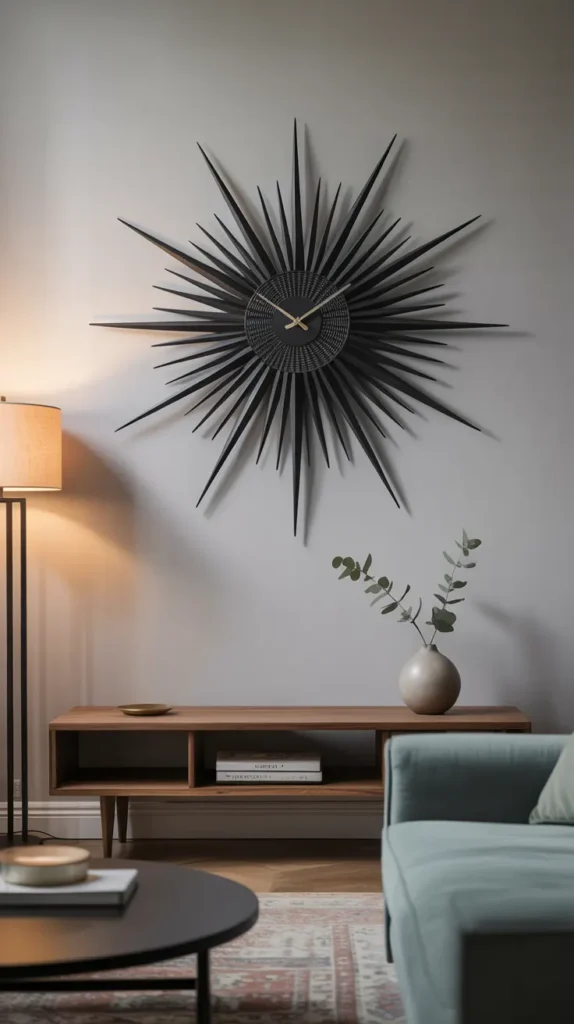
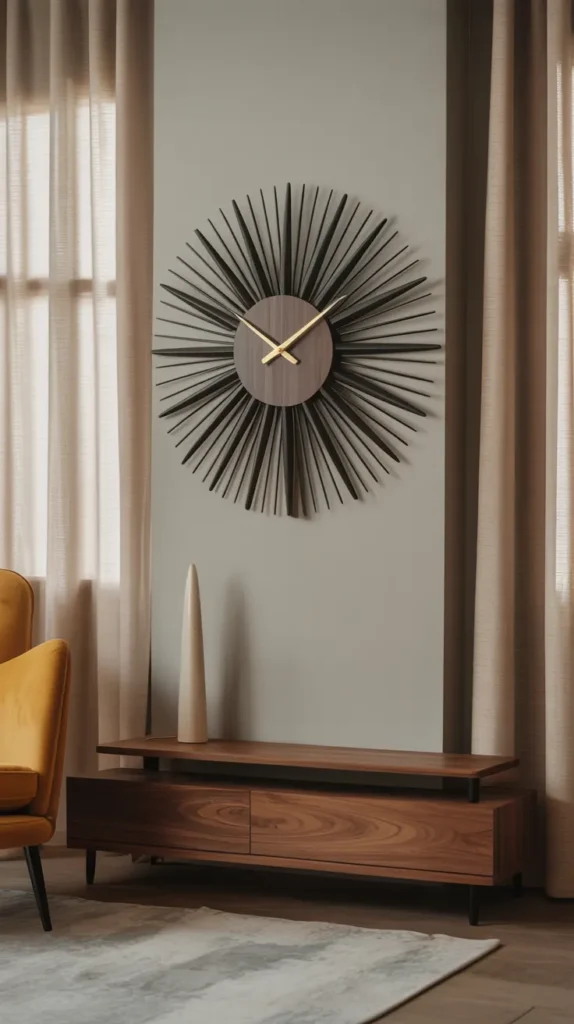
- Serve as a striking focal point on a main wall
- Add a metallic element to your color scheme
- Create a sense of energy and movement
- Pay homage to a classic mid-century motif without being too literal
For a contemporary twist, look for a sunburst design in a unexpected finish like matte black or natural wood instead of the traditional brass or gold.
7. Geometric Room Divider
Open floor plans are standard in mid-century design, but sometimes you need to create visual separation without walls. Enter the geometric room divider—a practical solution that doubles as a sculptural element.
Consider:
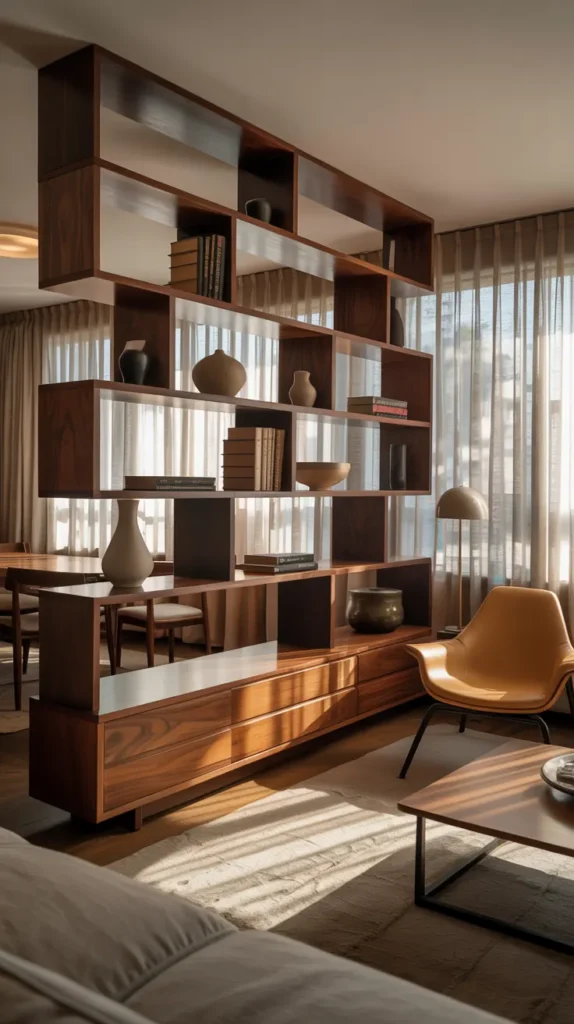
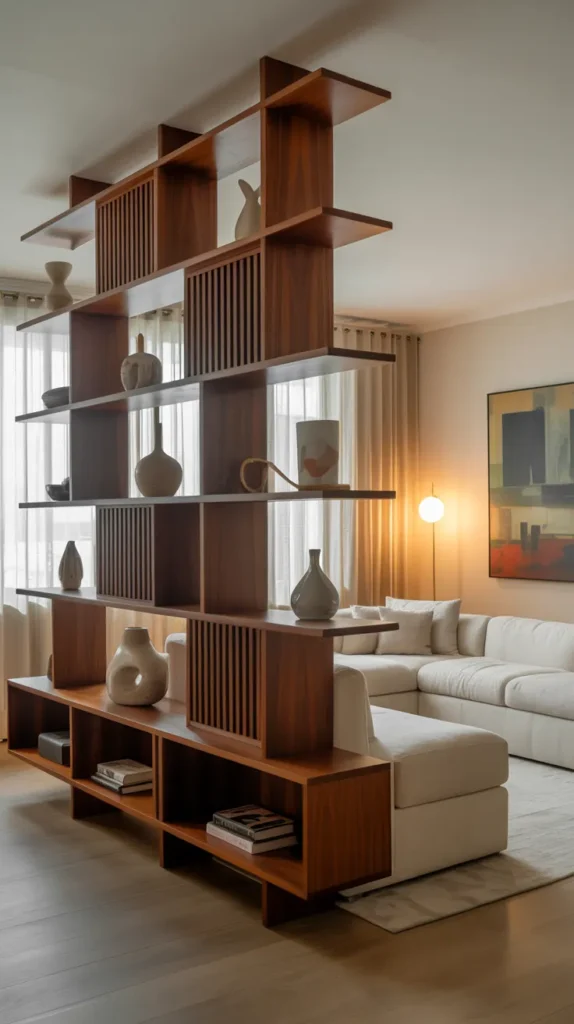
- A floating shelving unit that allows light to pass through
- A slatted wood screen that provides partial privacy
- A collection of hanging panels in wood or acrylic
- A custom unit that incorporates storage or display space
These dividers add architectural interest while honoring the mid-century principle of adaptable, multi-functional spaces. They’re particularly useful in lofts or large rooms where you want to delineate a living area from dining or work zones.
8. Abstract Art and Atomic Patterns
Mid-century modern coincided with abstract expressionism in the art world, and the two movements complement each other beautifully. Bold, non-representational artwork adds energy and personality to the clean lines of mid-century furniture.
Look for art and patterns featuring:
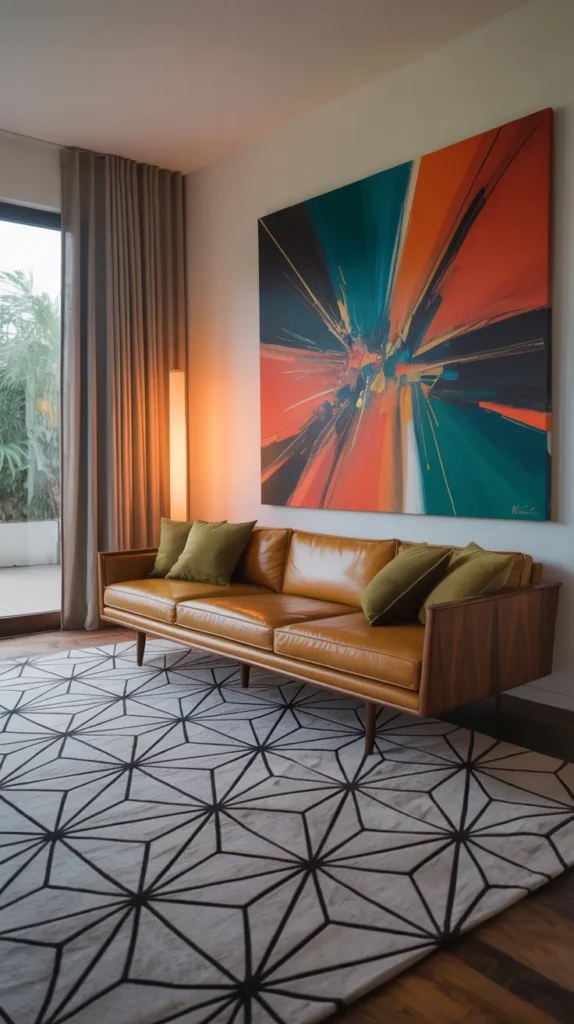
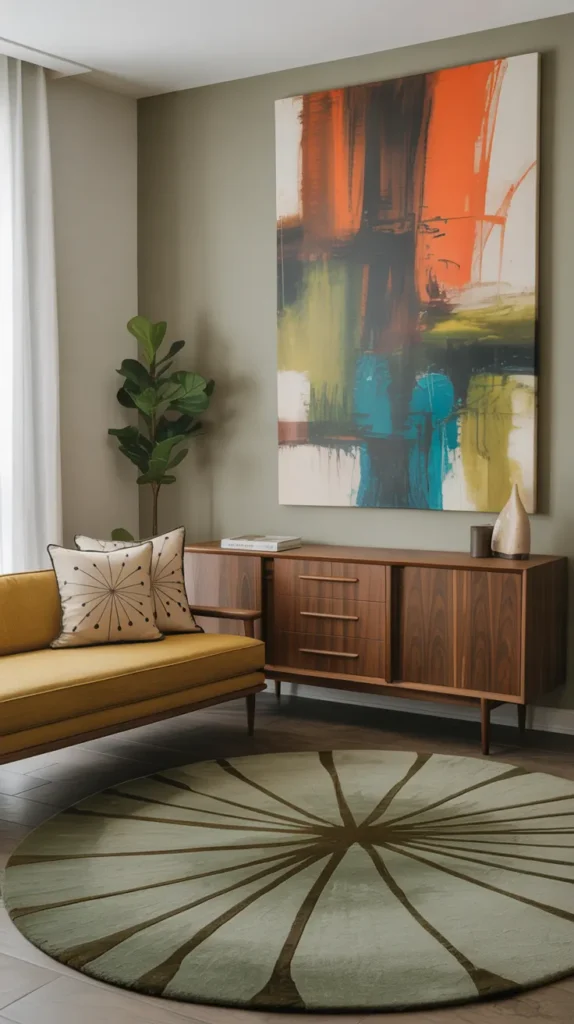
- Organic, amoeba-like shapes
- Geometric abstractions
- Bold, confident brushstrokes
- Atomic motifs like starbursts, boomerangs, or molecular structures
- Limited but vibrant color palettes
Art is where you can embrace some of the bolder colors associated with the era without overwhelming your space. A large abstract canvas in burnt orange or teal can become the cornerstone of your room’s color story.
9. Low-Profile Media Solution
Television sets were new and exciting during the mid-century era, but they were also furniture pieces designed to blend with the room rather than dominate it. Capture this balanced approach with a thoughtful media setup.
Consider:
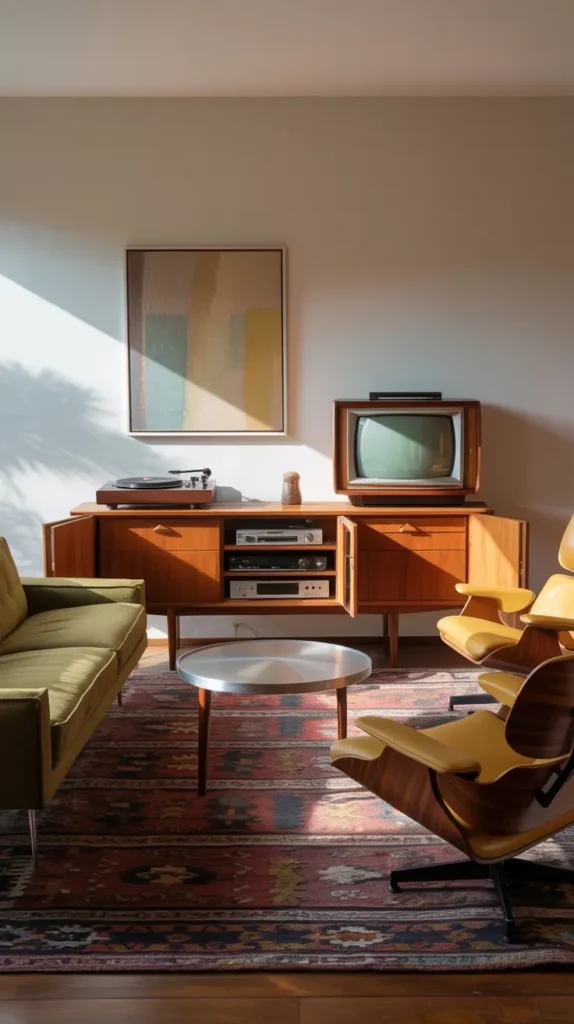
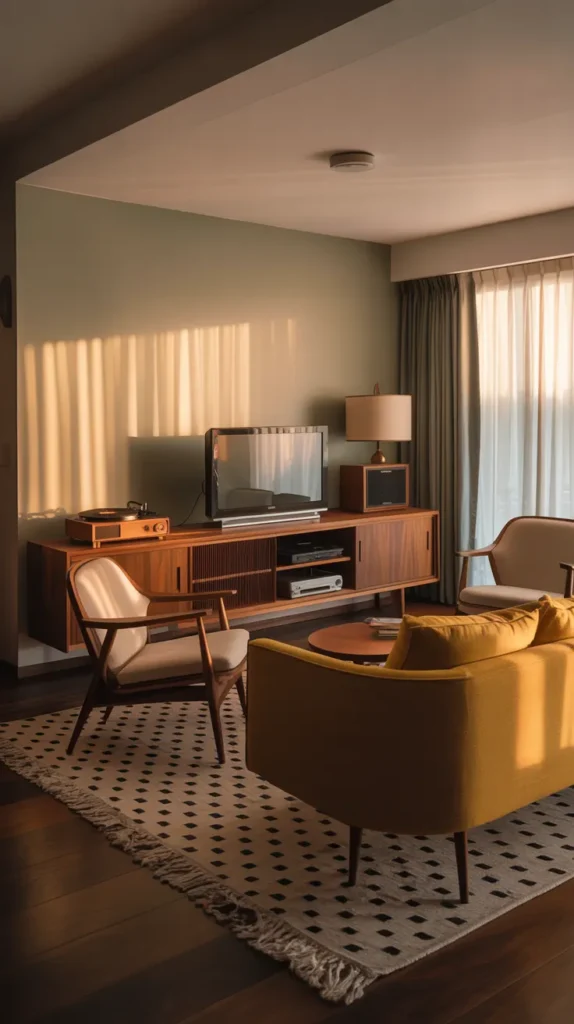
- A low, horizontal credenza that grounds the space
- A wall-mounted TV with minimal visible wiring
- A vintage-inspired record player station
- Technology concealed within cabinetry when not in use
This approach honors both the era’s embrace of new technology and its emphasis on clean, uncluttered spaces where human interaction takes precedence.
10. Glass and Wood Coffee Table
The coffee table sits at the heart of most living rooms, and in mid-century design, these pieces often feature the perfect marriage of wood and glass that defines the era’s material palette.
Look for tables with:
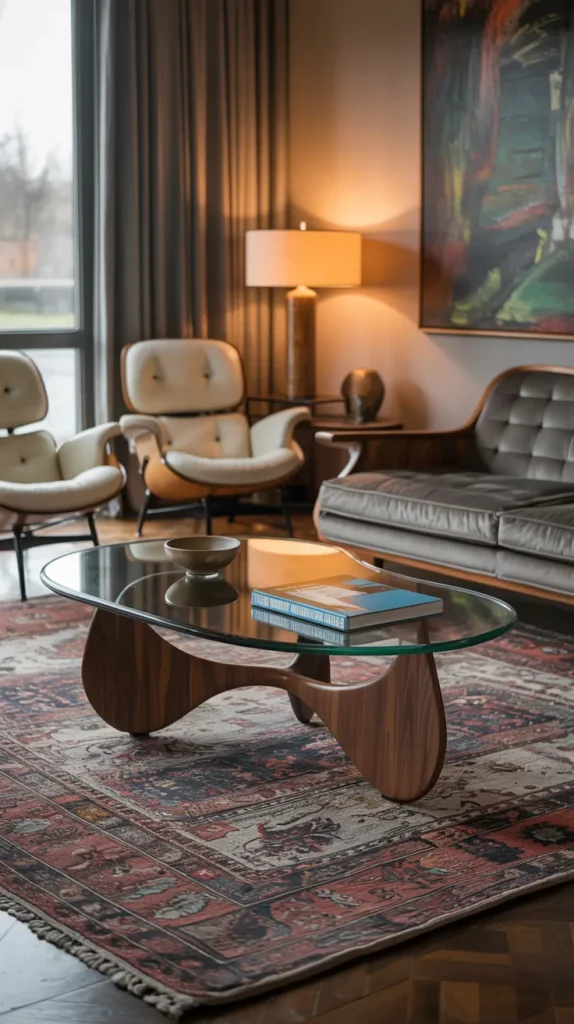
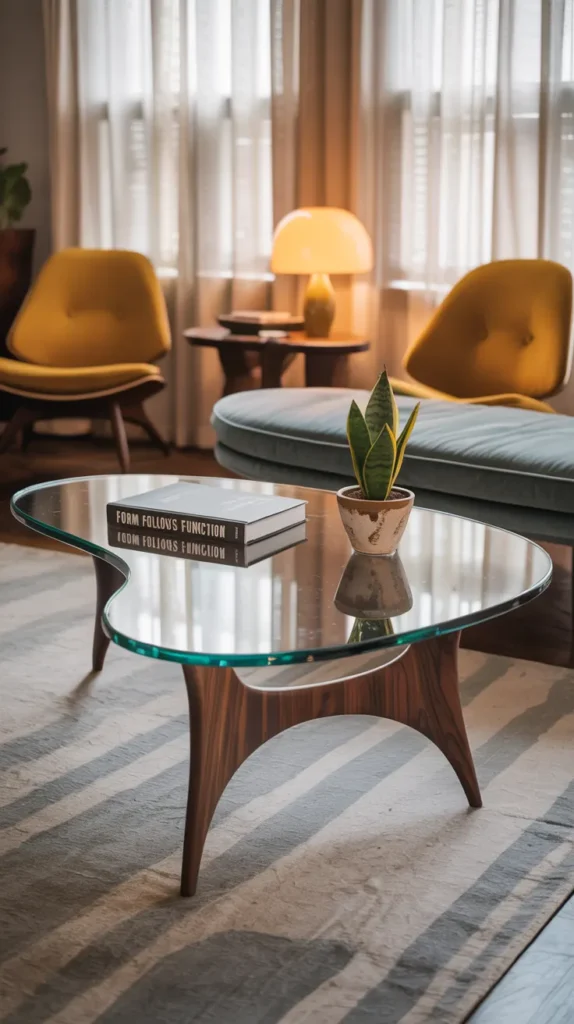
- Organic shapes like kidneys, triangles, or amoebas
- Wooden bases with sculptural elements
- Glass tops that create visual lightness
- Tapered or hairpin legs
- Multiple levels or nesting capabilities
A distinctive coffee table can anchor your entire design scheme, providing both a functional surface and a conversation piece that embodies mid-century principles.
11. Bar Cart Moment
Entertaining was an art form during the mid-century period, and the bar cart was its rolling embodiment. Even if you’re not a cocktail enthusiast, a stylish bar cart adds vintage charm and practical storage to a mid-century living room.
Stock your cart with:
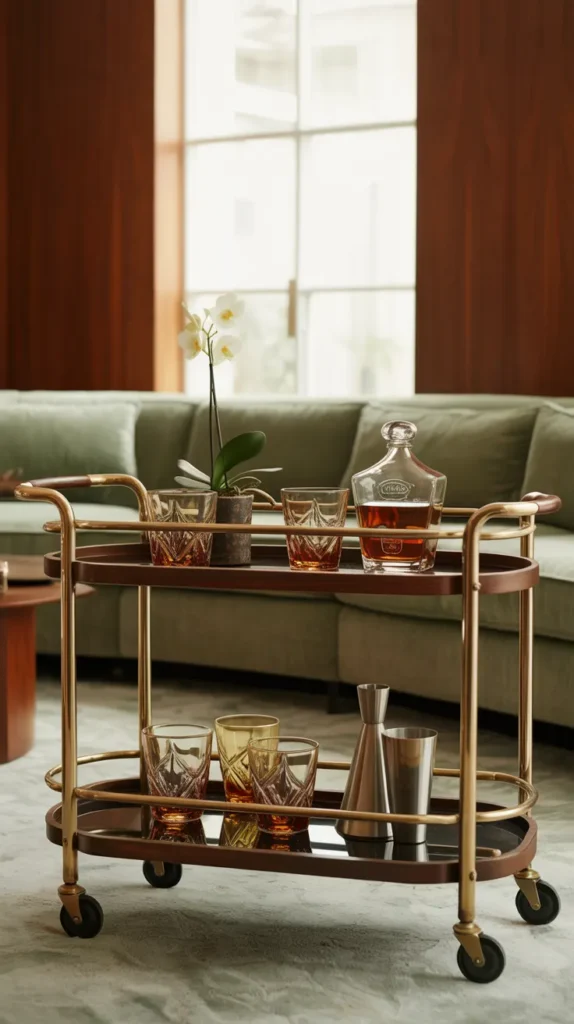
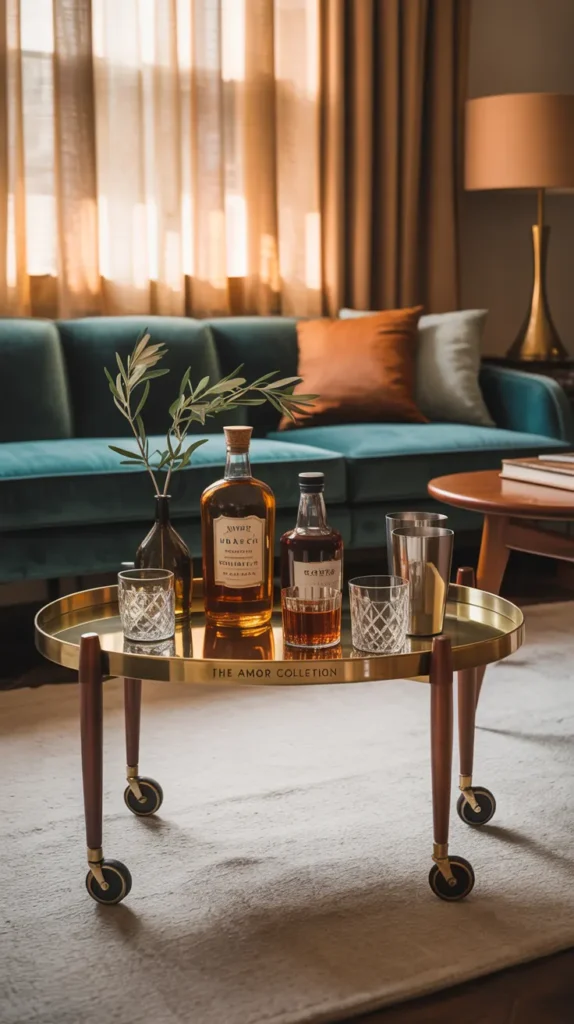
- A curated selection of glassware (bonus points for authentic vintage pieces)
- A few quality spirits or non-alcoholic alternatives
- Mixing tools with clean, modern lines
- A small plant or floral arrangement for freshness
- Coffee table books related to mid-century design or cocktail culture
Position your cart near your main seating area to encourage spontaneous hospitality—a value deeply embedded in mid-century modern lifestyle.
12. Slatted Wood Accent Wall
Vertical wood slats were a common architectural feature in mid-century homes, adding texture and warmth while maintaining the clean, linear aesthetic of the style. A slatted wood wall or partial wall treatment brings instant mid-century character to contemporary spaces.
This feature can:
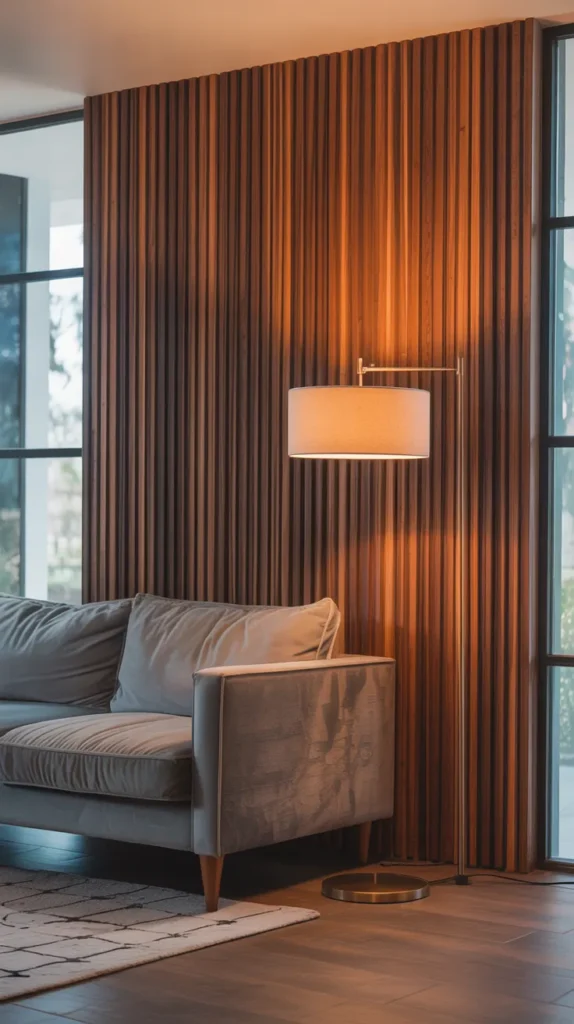
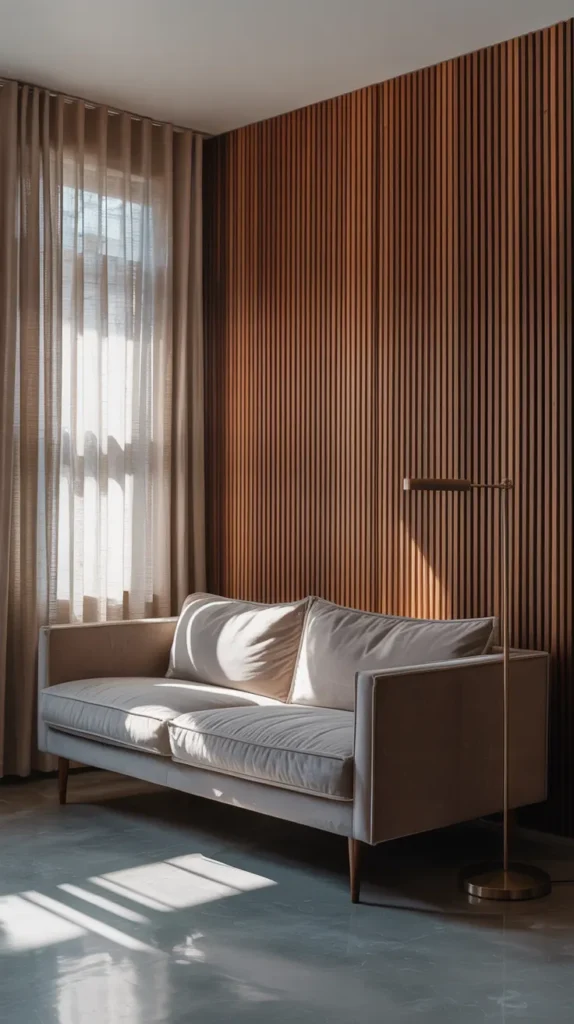
- Create a focal point behind a sofa or TV
- Add warmth and texture to a room with many hard surfaces
- Improve acoustics in open floor plans
- Provide a backdrop for artwork or a wall-mounted television
For an updated take, consider slats in varying widths or with small spaces between them that allow the wall color to show through, creating depth and shadow play.
13. Sculptural Planters with Lush Greenery
Houseplants were essential elements in mid-century interiors, reflecting the style’s connection to nature and organic forms. Pairing distinctive planters with the right plants creates living sculptures that animate your space.
For an authentic mid-century look:
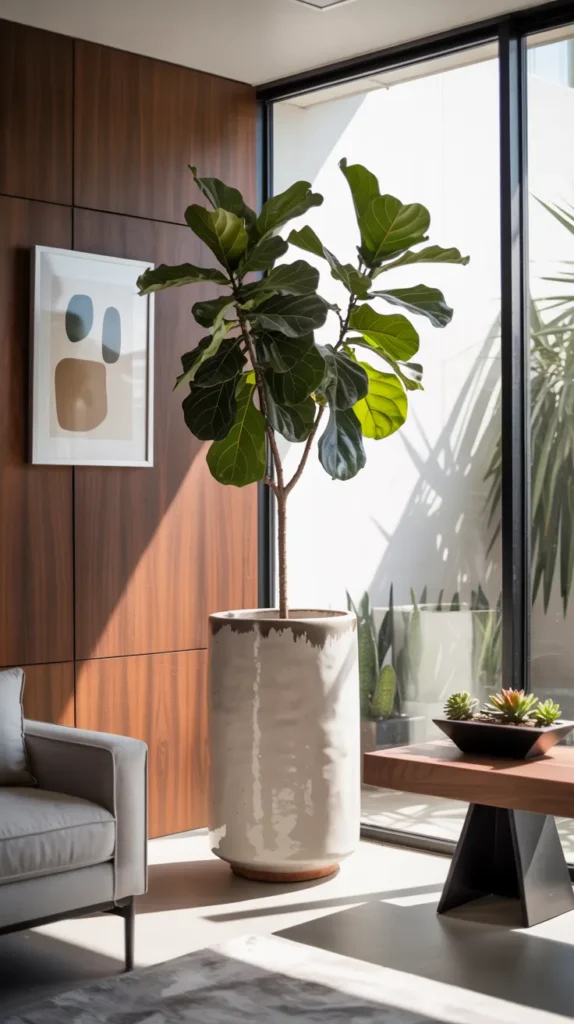
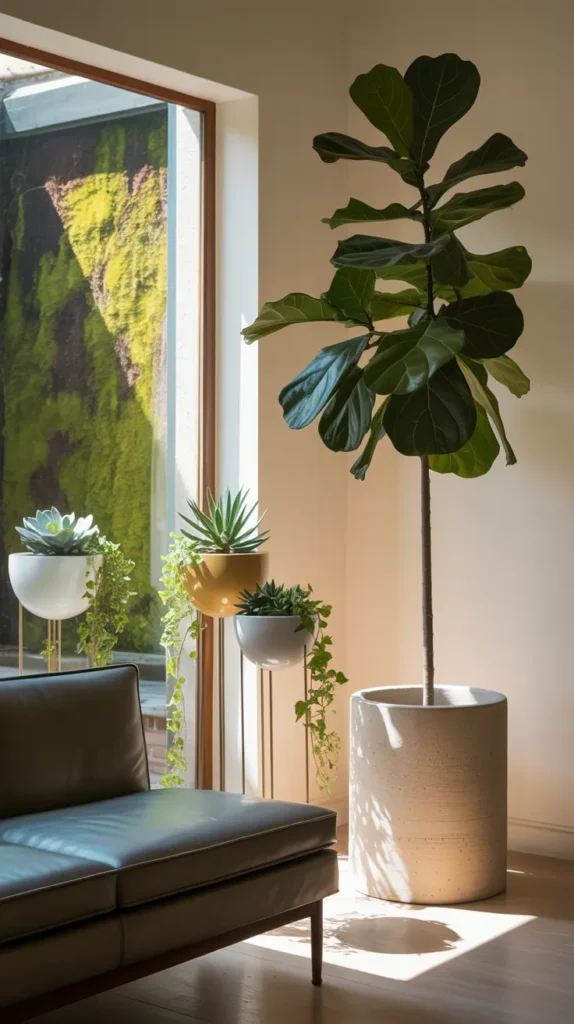
- Choose planters with architectural qualities—cylinders, bullets, or geometric forms
- Select plants with strong silhouettes like fiddle leaf figs, rubber plants, or palms
- Elevate plants on stands to create height variation
- Cluster different plants to create a deliberate indoor landscape
- Look for ceramic planters in white, black, or earthy glazes
Plants add life, color, and texture to the sometimes minimal mid-century aesthetic, while improving air quality and connecting indoor spaces to the natural world—a core principle of the style.
14. Floating Shelves for Curated Display
Mid-century modern isn’t about displaying vast collections of objects, but rather about showcasing a few carefully chosen pieces with room to breathe. Floating shelves provide the perfect platform for this curated approach.
On your shelves, arrange:
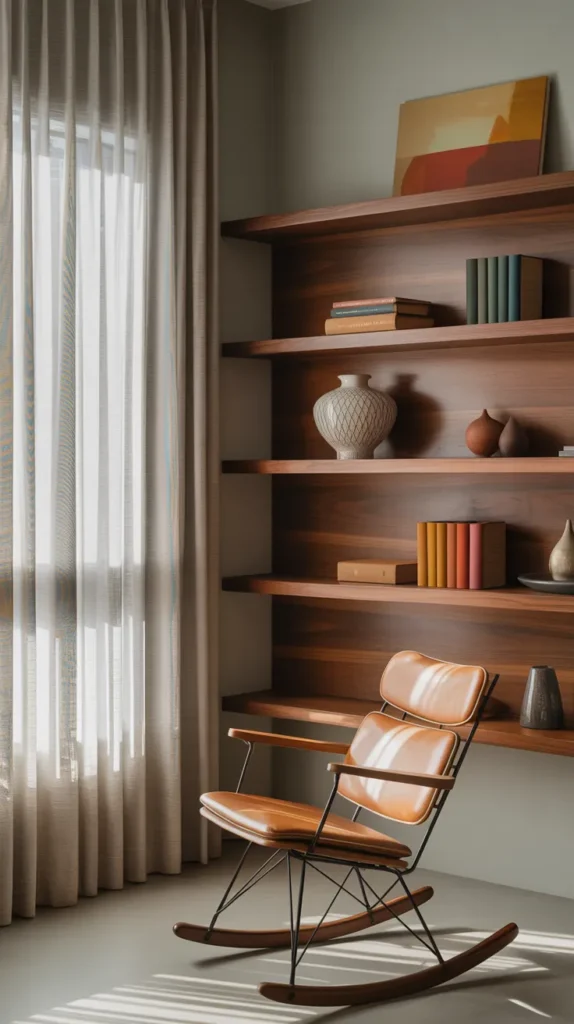
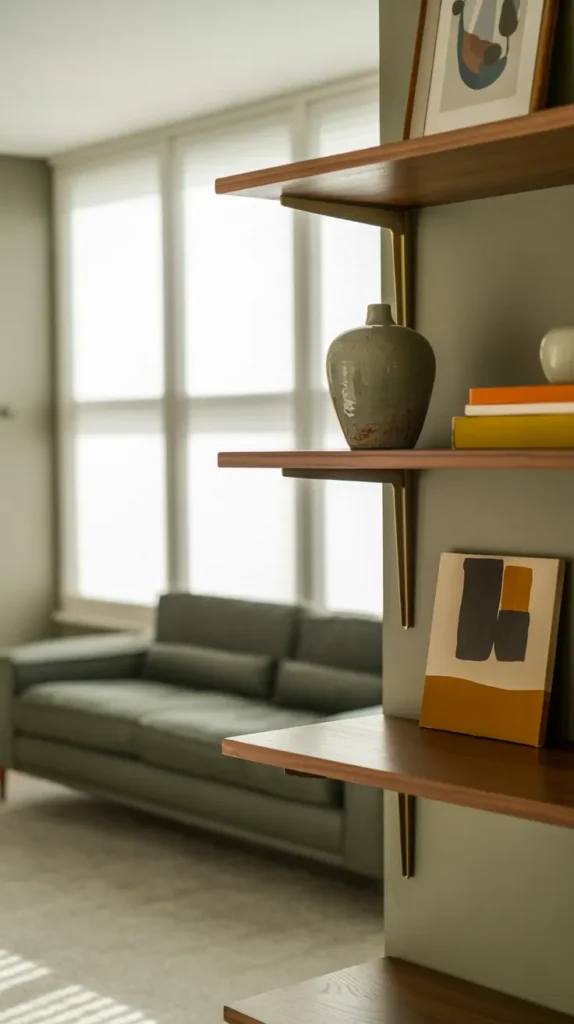
- A few decorative objects with interesting shapes or materials
- Books with colorful spines that complement your color scheme
- Small pieces of art that might get lost on a larger wall
- Vintage finds that reference the mid-century era
The key is restraint—leave plenty of negative space around each item so their forms can be appreciated individually rather than creating visual clutter.
15. Layered Textural Neutrals
While color gets a lot of attention in discussions of mid-century style, many iconic interiors from the period actually rely on subtle variations in texture and neutral tones to create visual interest.
Create depth through:
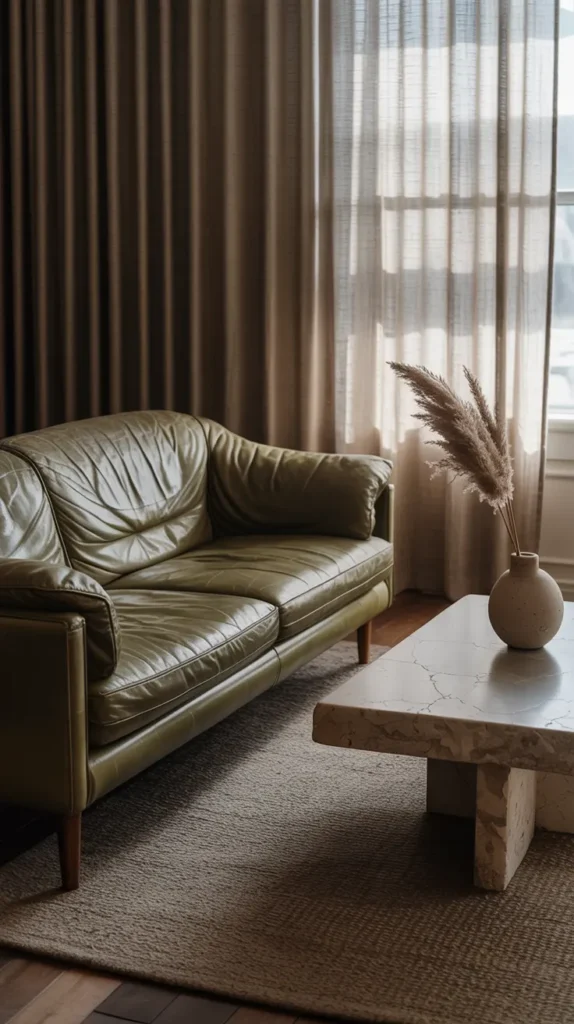
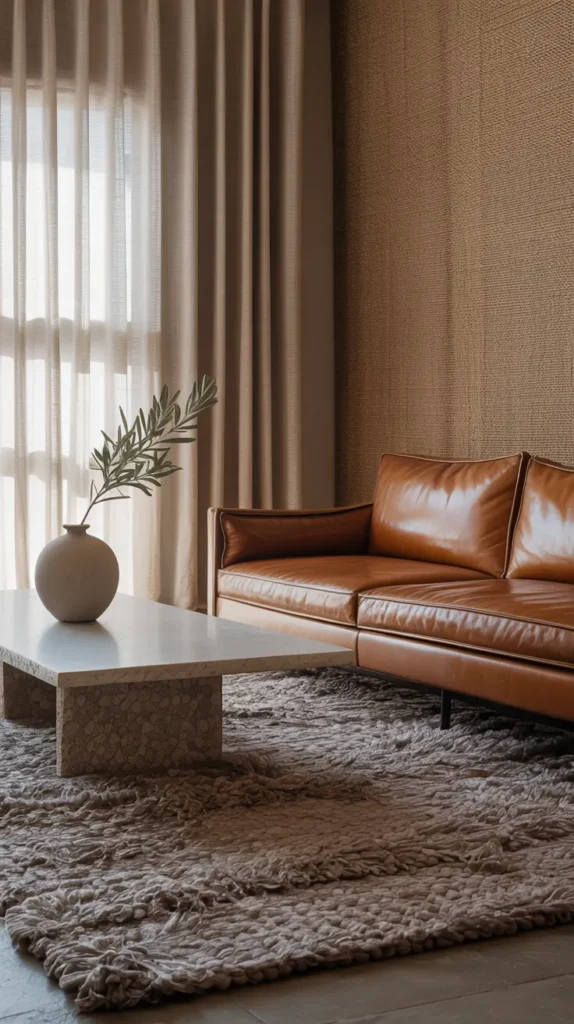
- A nubby wool area rug in oatmeal or taupe
- Linen curtains that filter light beautifully
- Leather upholstery that develops patina over time
- Textured wall treatments like grasscloth or subtle plaster
- Natural stone elements in coffee tables or accessories
This approach creates a sophisticated, timeless backdrop that allows architectural features and key furniture pieces to shine without distraction.
16. Conversation-Starting Lighting
Beyond the sputnik chandelier, mid-century design gave us countless innovative lighting solutions that combine functionality with sculptural beauty. Statement lighting acts as functional art in a well-designed mid-century living room.
Look for:
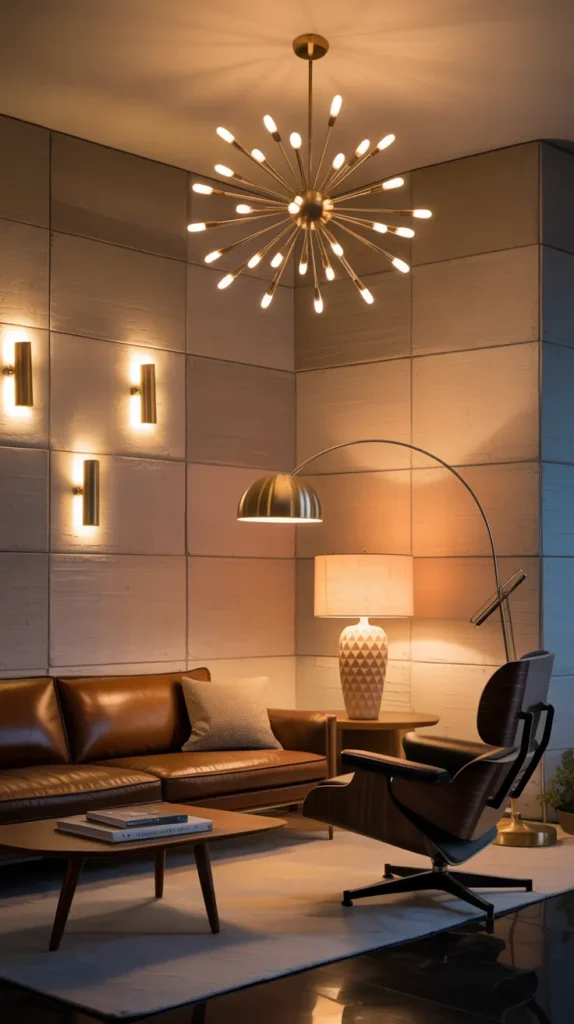
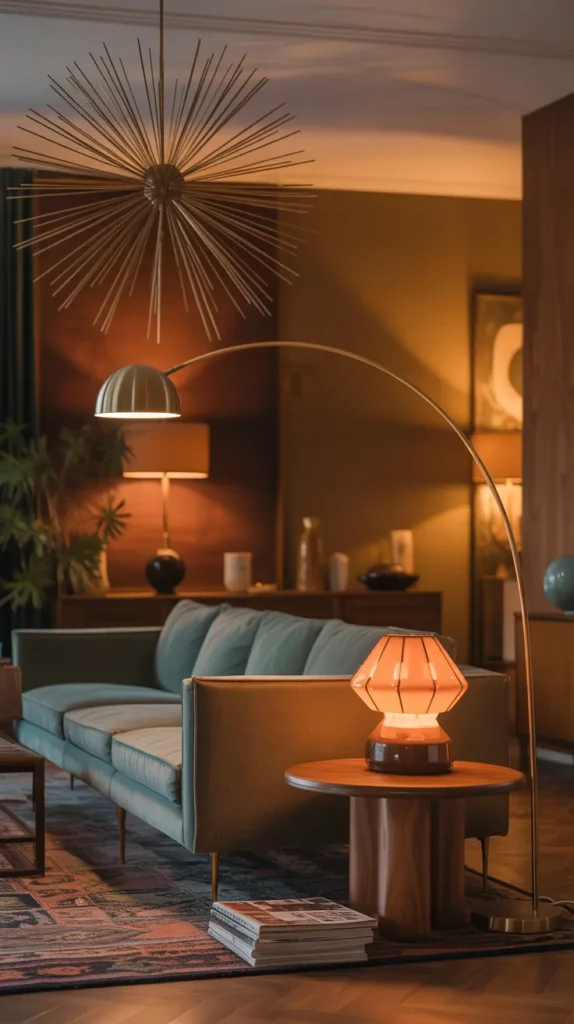
- Floor lamps with adjustable arms or heads
- Table lamps with ceramic bases in organic shapes
- Pendant lights with unusual materials or forms
- Sconces that create dramatic wall washing effects
- Arc floor lamps that eliminate the need for ceiling fixtures
Thoughtful lighting transforms the atmosphere of a room as day transitions to evening, an experience central to the mid-century modern lifestyle.
17. Geometric Area Rug as Foundation
An area rug isn’t just practical—it can establish your color scheme, define your seating area, and introduce pattern in an otherwise clean-lined space. Mid-century rugs often feature geometric patterns or abstract designs that complement the furniture’s simple forms.
For an authentic look:
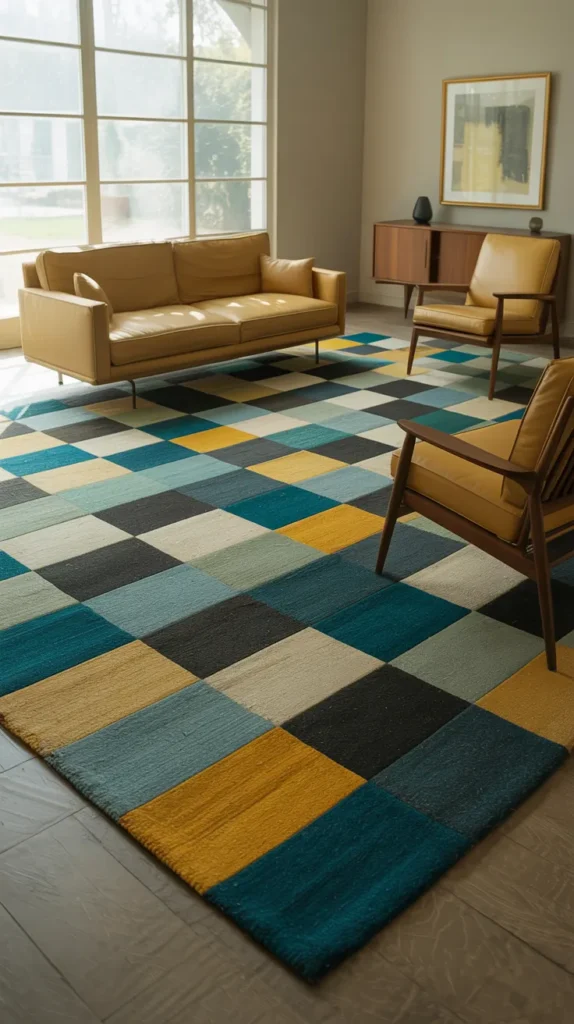
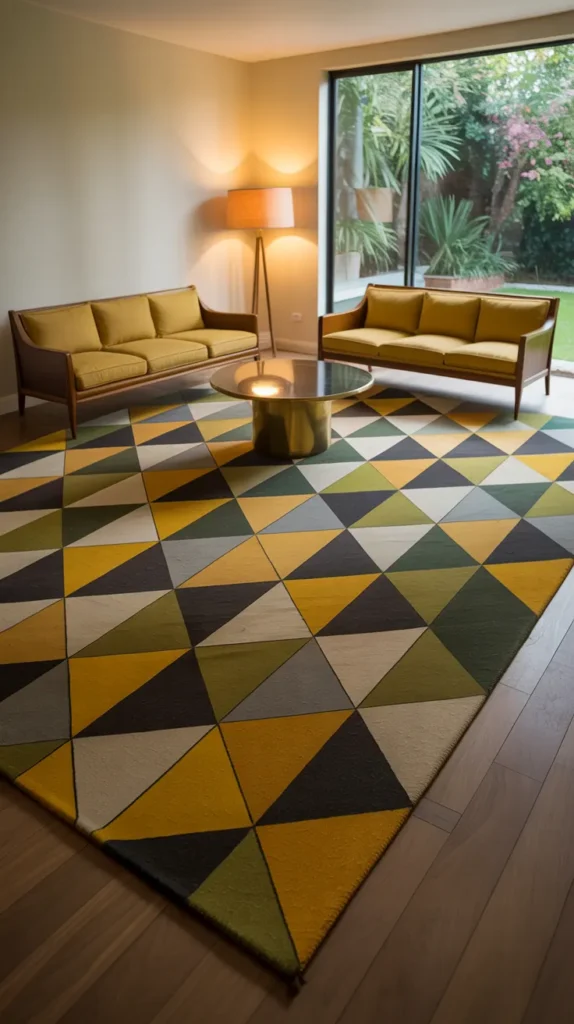
- Choose patterns with irregular shapes or asymmetrical designs
- Look for rugs with both straight lines and organic forms
- Consider flatweave constructions which were popular during the period
- Select colors that pull from both your furniture and accessories
- Ensure the rug is properly sized—it should connect all main seating pieces
A well-chosen rug unifies the elements in your living room while adding personality and comfort—essential qualities in mid-century spaces that prioritized both style and livability.
18. Wall-Mounted Shelving Systems
One of the most revolutionary mid-century design innovations was the modular, wall-mounted shelving system. These customizable units float above the floor, creating a sense of space while providing essential storage and display areas.
Consider systems that feature:
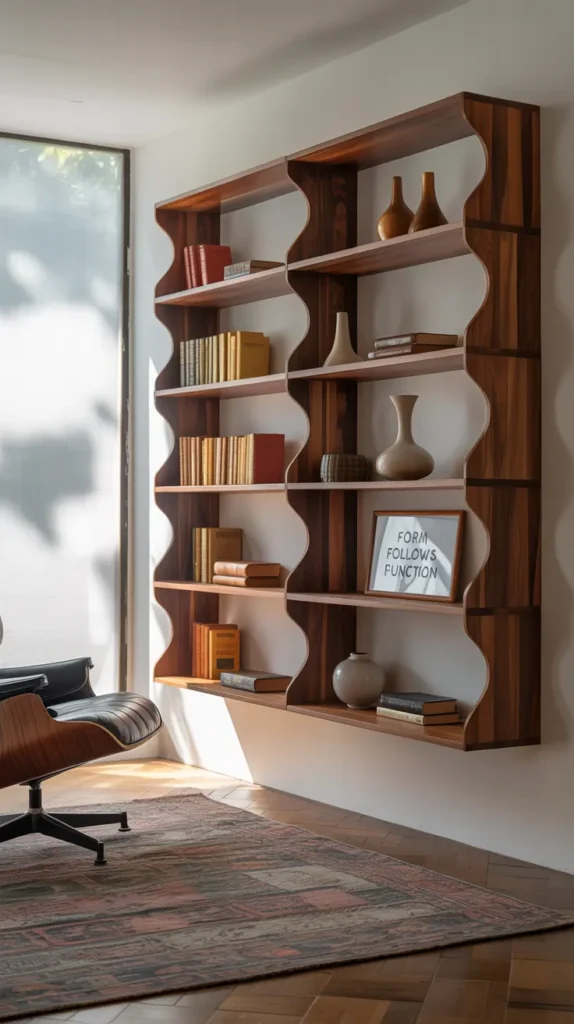
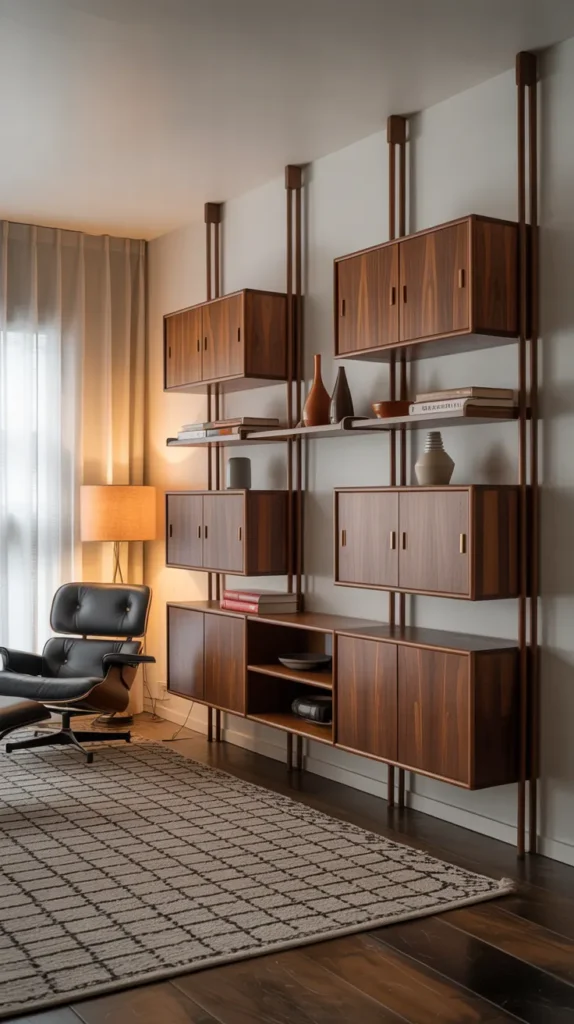
- Adjustable components that can change as your needs evolve
- A mix of open shelving and closed cabinet space
- Vertical supports that create rhythm along the wall
- Materials that complement your other wood tones
- Opportunities to display both practical items and decorative objects
These systems embody the mid-century principles of flexibility, functionality, and clean design—perfect for contemporary living rooms where versatility is valued.
19. Cozy Conversation Corner
Not every mid-century living room has to be large and open. The era also gave us intimate furniture groupings designed for meaningful conversation—something increasingly valuable in today’s distracted world.
Create your own conversation corner with:
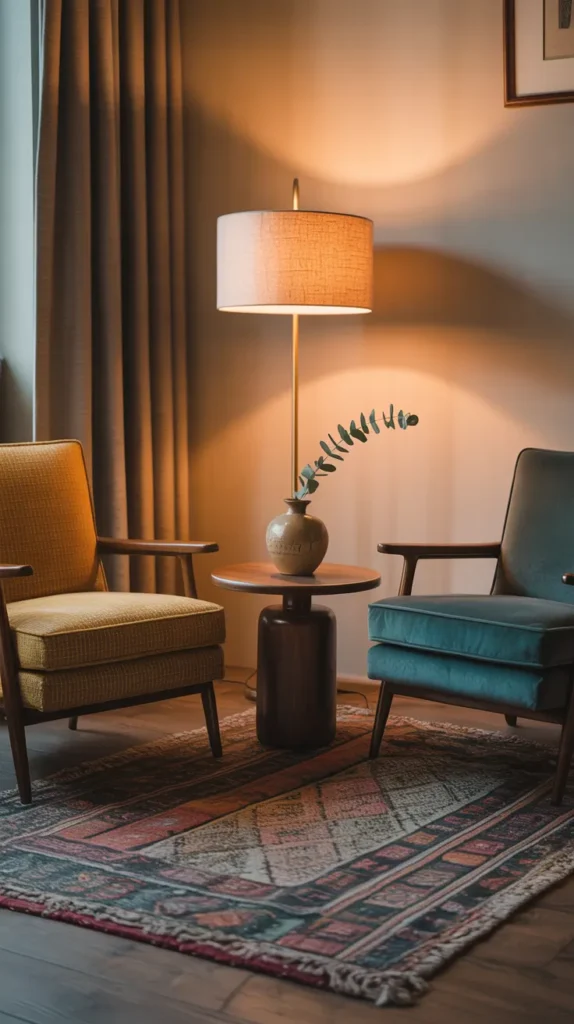
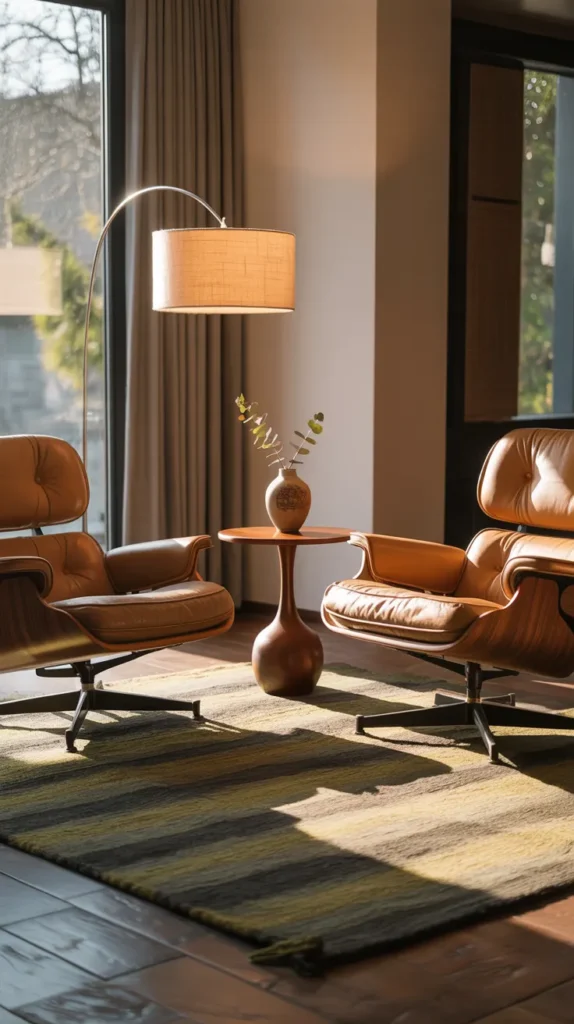
- Two facing armchairs with a small table between them
- A floor lamp positioned for optimal reading light
- A small ottoman or stool that can serve multiple purposes
- A side table large enough for drinks or a chess board
- A textural rug to define this area within a larger room
This arrangement creates a dedicated space for unplugged interaction while showcasing iconic mid-century chair designs—a win-win for both aesthetics and lifestyle.
20. Mixed Material Coffee Table
If you’re drawn to the mid-century aesthetic but want to avoid a space that looks too perfectly matched or reproduced, consider a coffee table that combines materials in unexpected ways.
Look for combinations like:
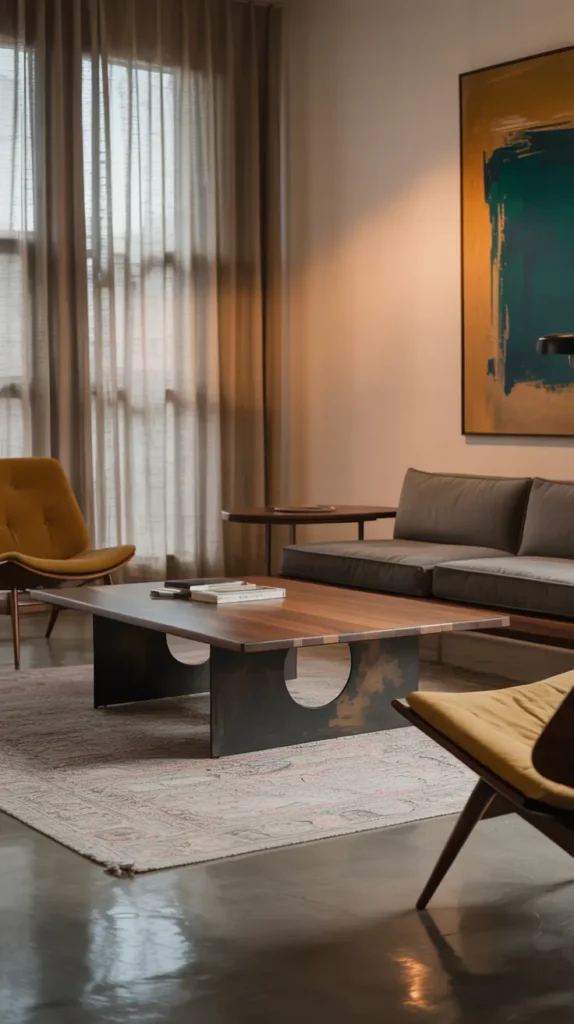
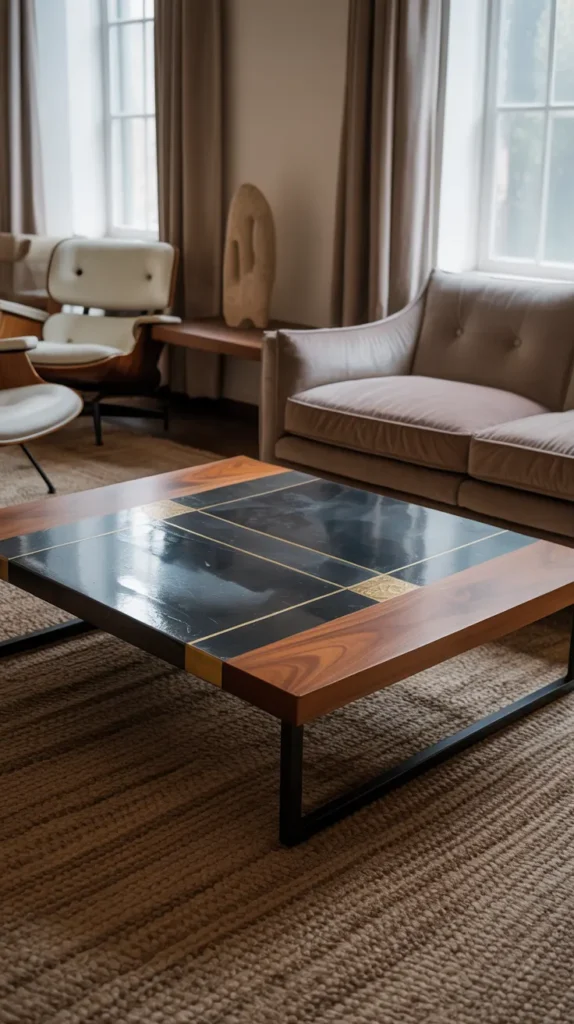
- Wood with marble or stone tops
- Blackened steel with warm wood
- Concrete with brass inlays
- Glass with sculptural wood or metal bases
- Terrazzo with simple metal frames
These mixed-material pieces capture the mid-century spirit of material exploration while adding contemporary relevance to your space.
21. Indoor-Outdoor Flow
Perhaps no element is more fundamental to mid-century design than the seamless connection between indoor and outdoor spaces. While architectural features like walls of glass aren’t easily added to existing homes, you can still enhance this connection.
Consider:
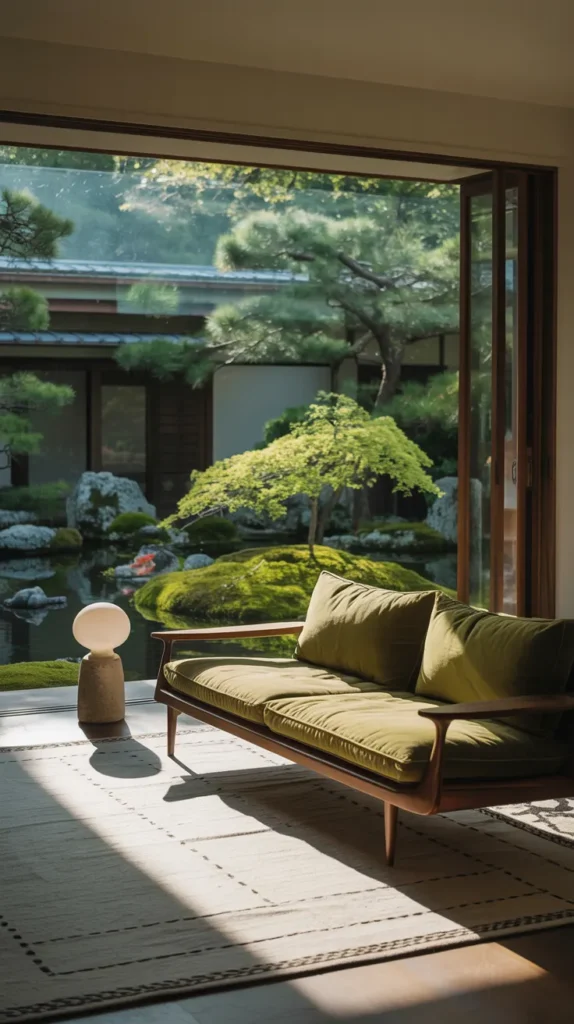
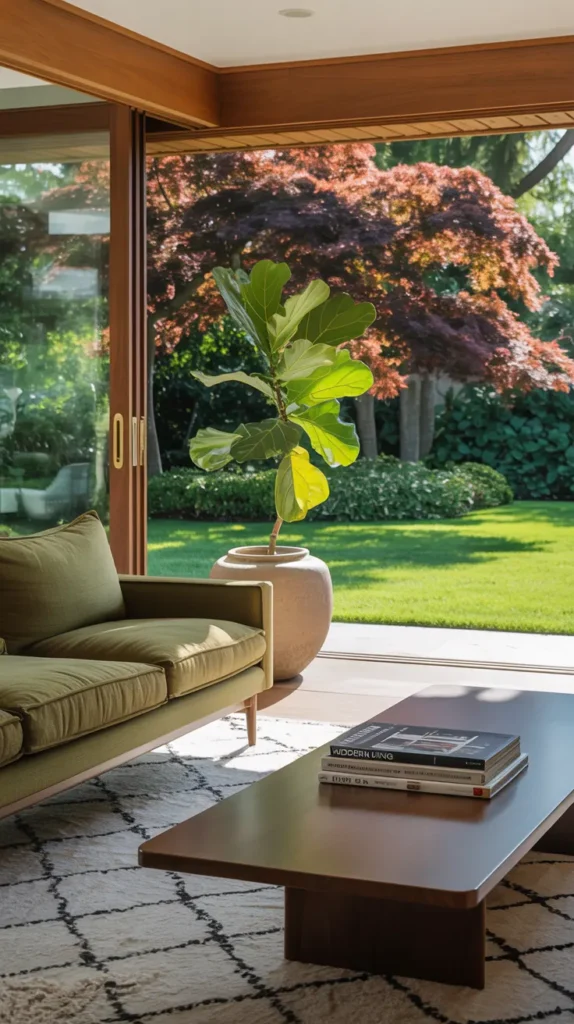
- Arranging furniture to face windows with attractive views
- Using similar materials and colors in adjacent outdoor spaces
- Adding a sliding door or expanding window openings where possible
- Positioning plants to create visual continuity between inside and out
- Choosing indoor-outdoor fabrics that can transition between spaces
This connection to nature and expanded sense of space was revolutionary in the mid-century era and remains deeply appealing today as we seek homes that feel both sheltering and expansive.
Making Mid-Century Modern Work for Real Life
The enduring appeal of mid-century modern design lies in its remarkable ability to be both practical and beautiful—a balance that’s particularly valuable in living rooms, where real life happens every day.
As you incorporate these ideas into your own space, remember a few guiding principles:
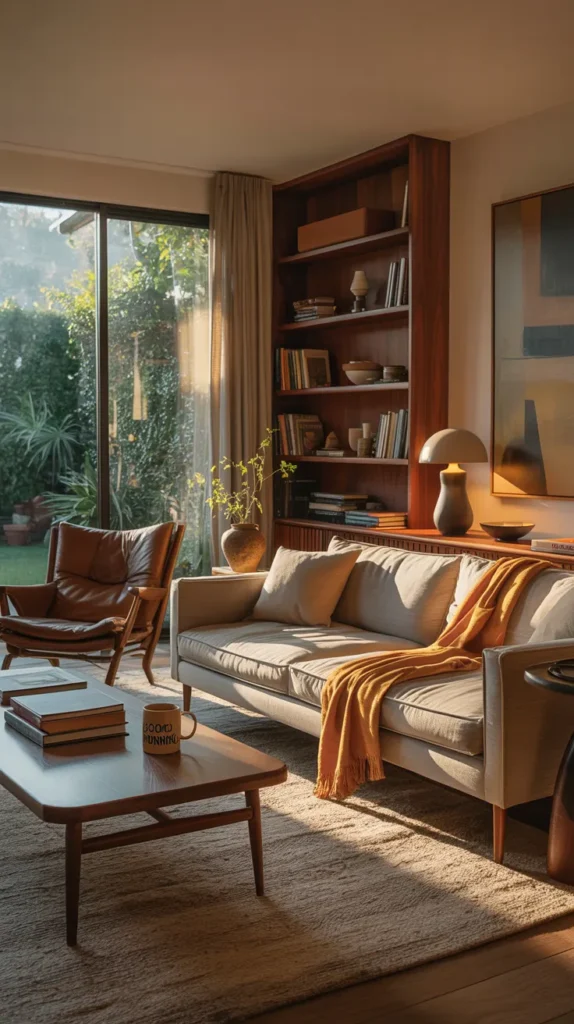
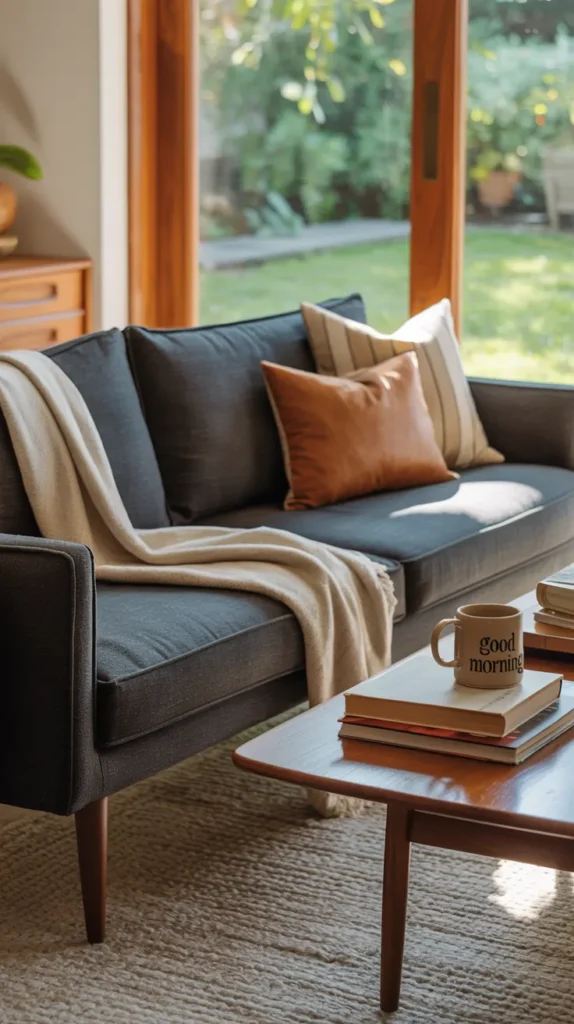
- Quality over quantity — Invest in fewer, better pieces rather than filling your space
- Authenticity over perfection — Mix in pieces you love even if they’re not strictly mid-century
- Function first — Stay true to the mid-century principle that beautiful things should also be useful
- Personal expression — The most successful mid-century spaces reflect their owners’ unique tastes
Whether you incorporate just a few mid-century elements or embrace the style wholeheartedly, the clean lines, organic influences, and thoughtful functionality of this design movement offer a timeless foundation for a living room that’s both stylish and genuinely livable.
After all, the best spaces aren’t the ones that look like they’re frozen in time—they’re the ones that take the best elements of the past and reinterpret them for how we live today.
